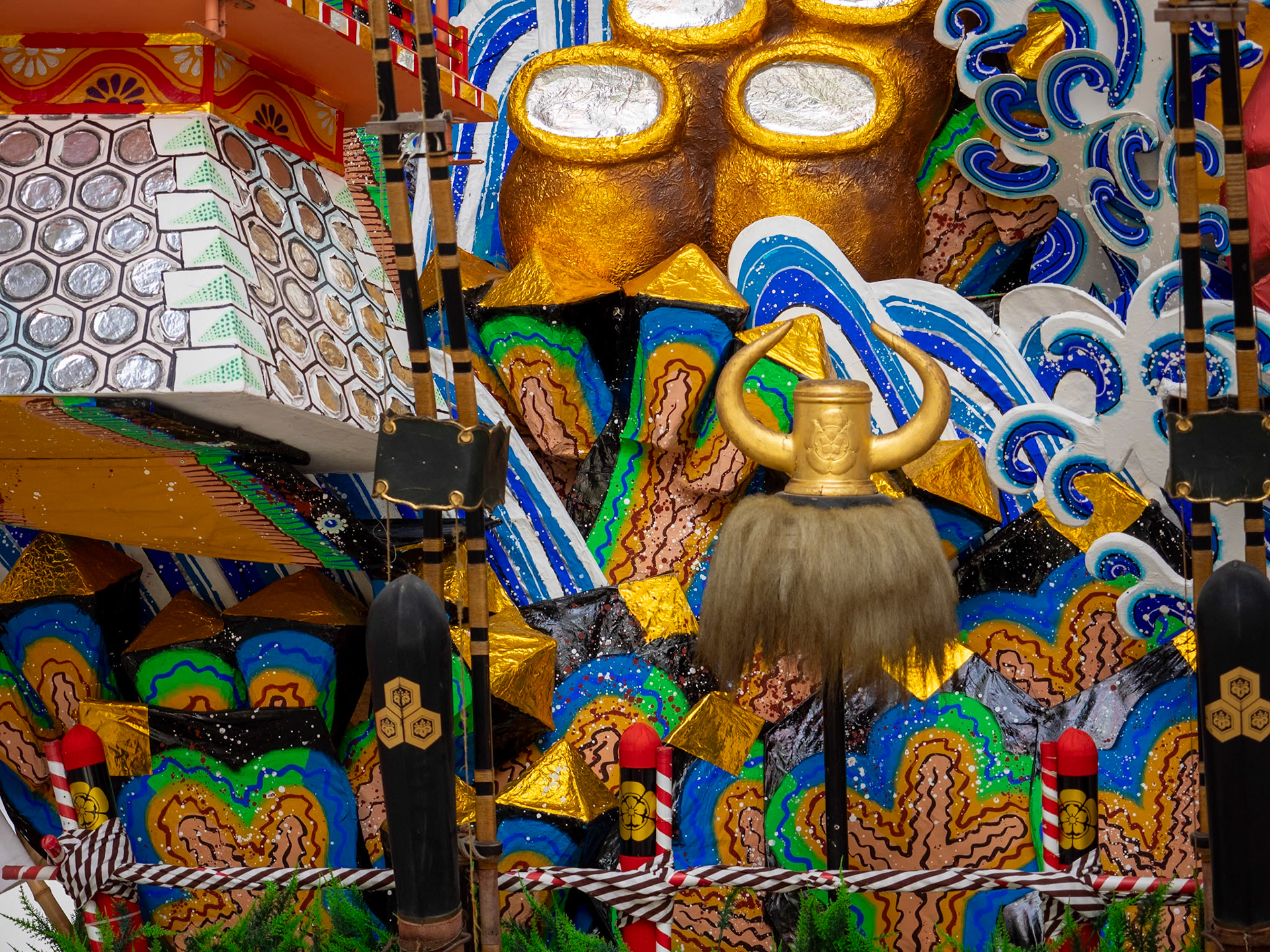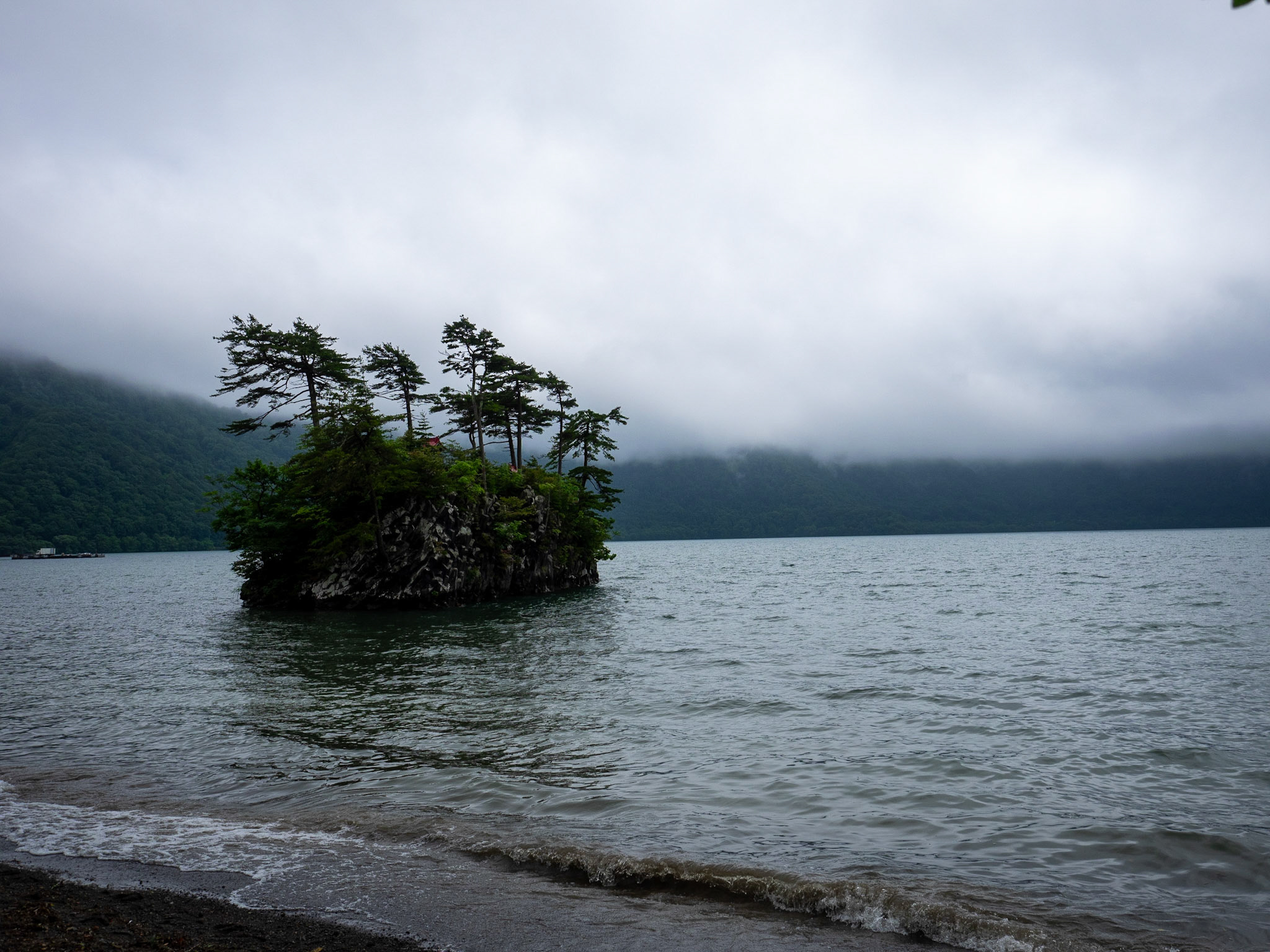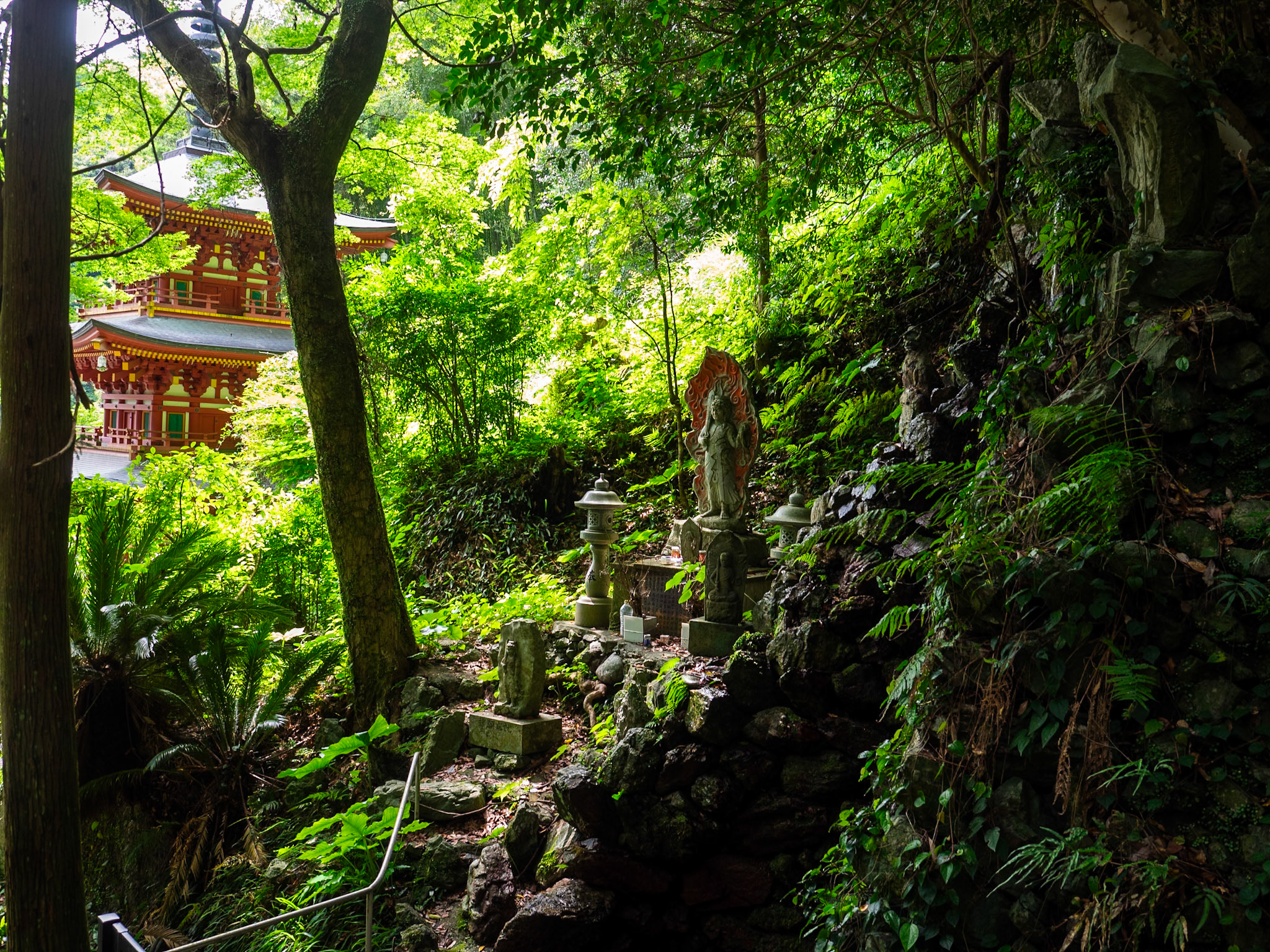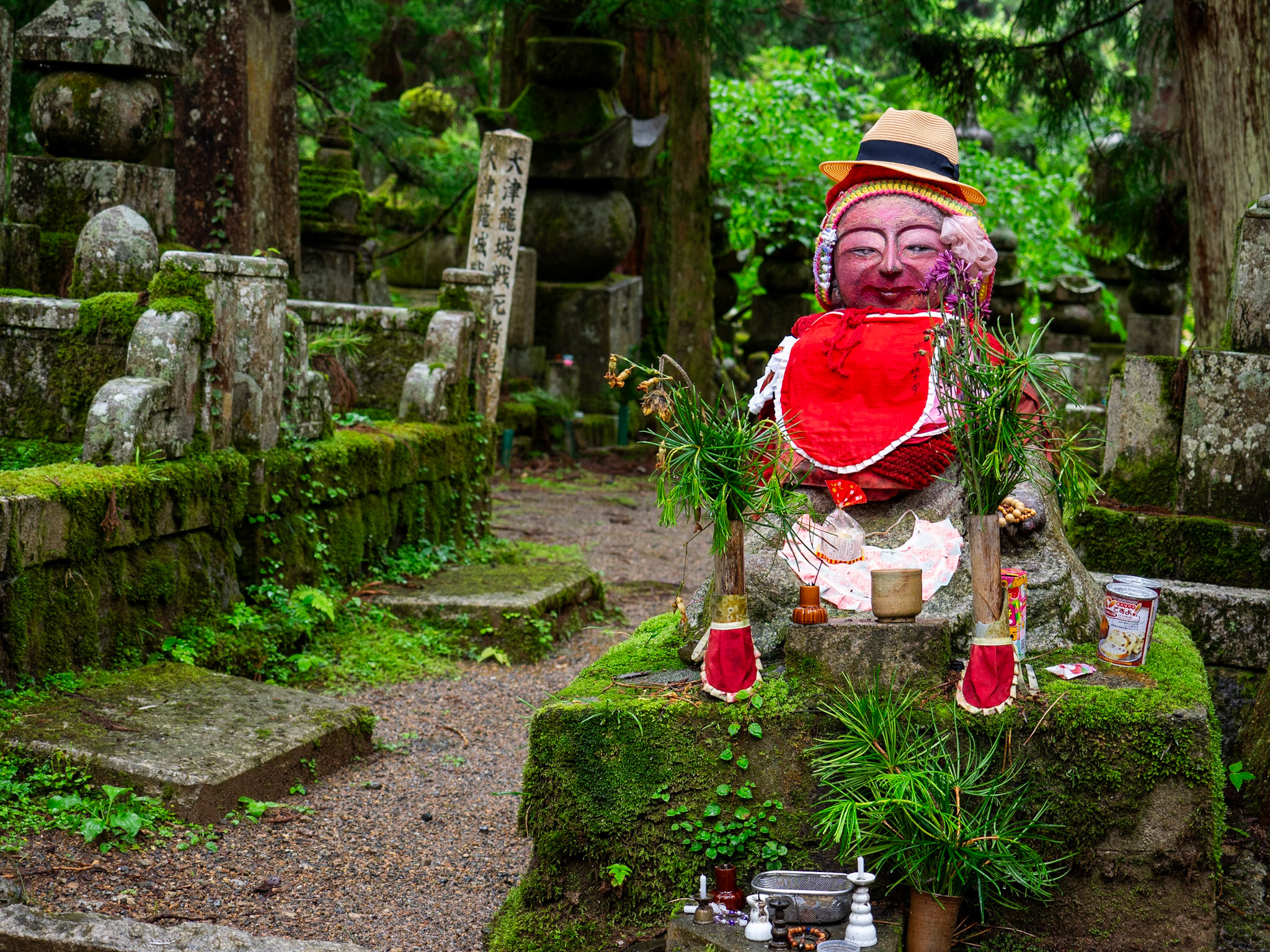Kirishima Jinga, Kyushu
Kyushu
2023
Travelling in Kyushu is both rewarding and remarkably straightforward. Particularly if you chooses to hire a car for all, or most, of your time, as many of Kyushu's quality attractions lie outside the cities in the form of isolated shrines, scenic vistas, remarkable geography, and the drive itself.
Kagoshima
Kagoshima is a friendly city near the southernmost point of Kyushu. The skyline is dominated by Sakurajima, a very very active volcano a few kilometres away across the bay. There are two main centres of activity, one near the shinkansen station, and the other downtown, easily connected by a straightforward tram system.
In Kagoshima itself, the main sight is probably the Reimekan Kagoshima History Museum, a modern building in the grounds of the old castle, with an imposing restored entrance gate. Many of the exhibits however are document based - letters, proclamations etc etc - which are of limited interest. And don't expect to come away with a clear picture of Kagoshima's key role in the Meiji restoration, with the Kagoshima region provided both key drivers of this monumental shift, and some of the last, most conservative, hold outs against change. All this is balanced out by some cute automated dioramas of life in Kagoshima post Restoration.
Again, it's straightforward to catch the frequent ferries across to Sakurajima from the ferry terminal. On Sakurajima, apart from the street signs showing off their enormous radishes, there's an excellent small, free, Visitor Centre an easy stroll from the ferry terminal. This has some fascinating geological displays, and info on just how temperamental & destructive Sakurajima has been. A scenic tourist bus has a stop right outside the Visitor Centre that will take you round various observation points on a hop on, hop off basis.
A few kilometres north of the city, along the bay, is what's Kagoshima's most interesting sight, Sengan-en. This area consists of both a very interesting garden, with the thinking behind it's layout & water features very obvious, and a series of early industrial buildings & museum displays. Don't miss the upper garden area, Kyokusui, which is particularly scenic, complete with a poetry stream, and was forgotten for many years.
Kagoshima is justly famous for it's food specialities, ranging from black pork (a breed, not the colour) to kibinago, a small herring, eaten as sashimi or fried. And of course the shochu, which does vary considerably in taste & quality - if in doubt best to drown it in lemon soda as do many locals. In terms of where to eat, choices abound, but it's worth mentioning the food stalls set up in the basement area under the Solaria Hotel near the station, and connected to the station by underground walkways. Here some 16 to 20 different vendors each offer their own Kagoshima specialities, though with only a dozen or so seats per stall, sometimes it's a matter of what's available.
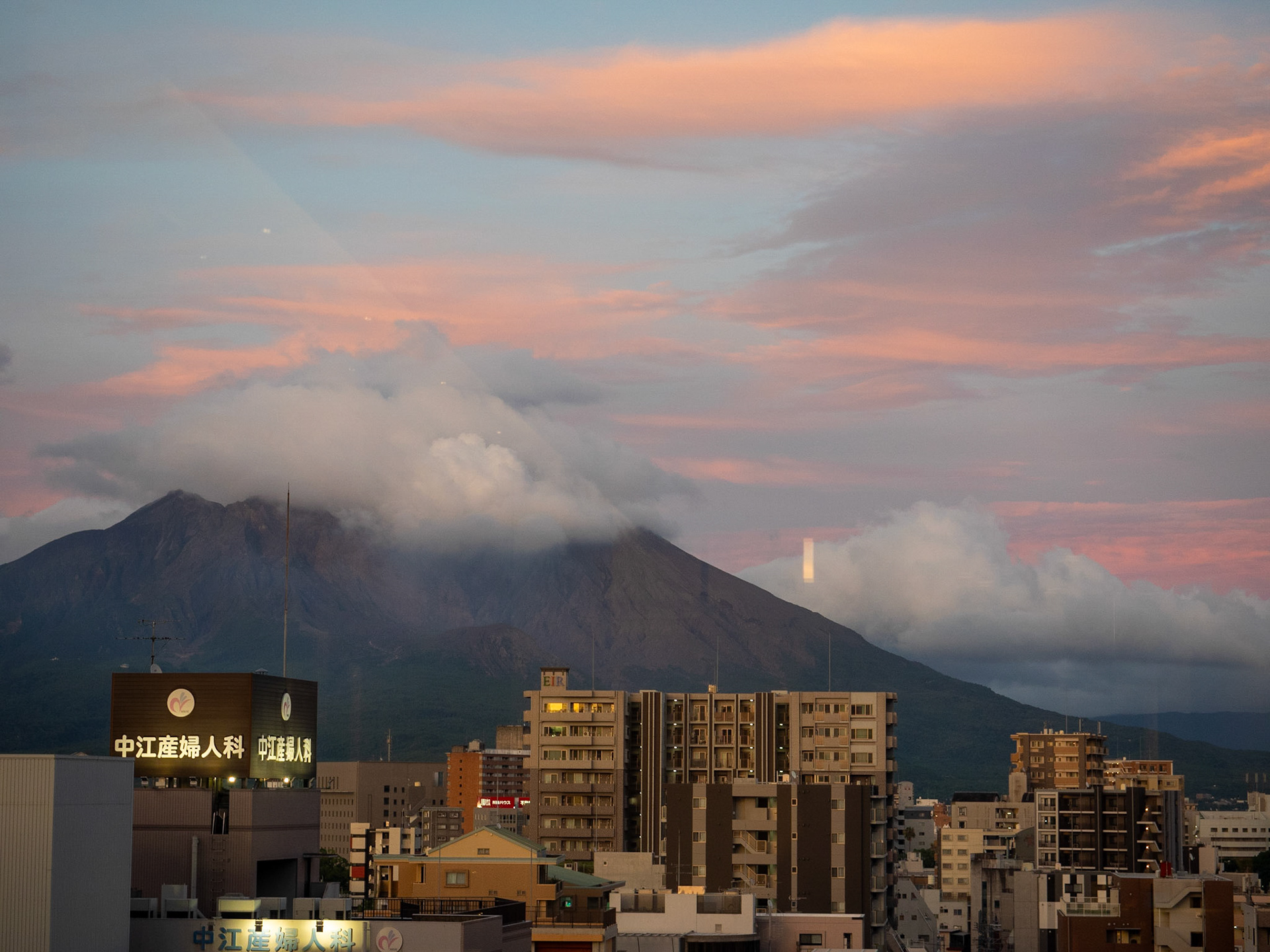
Sakurajima, Kagoshima
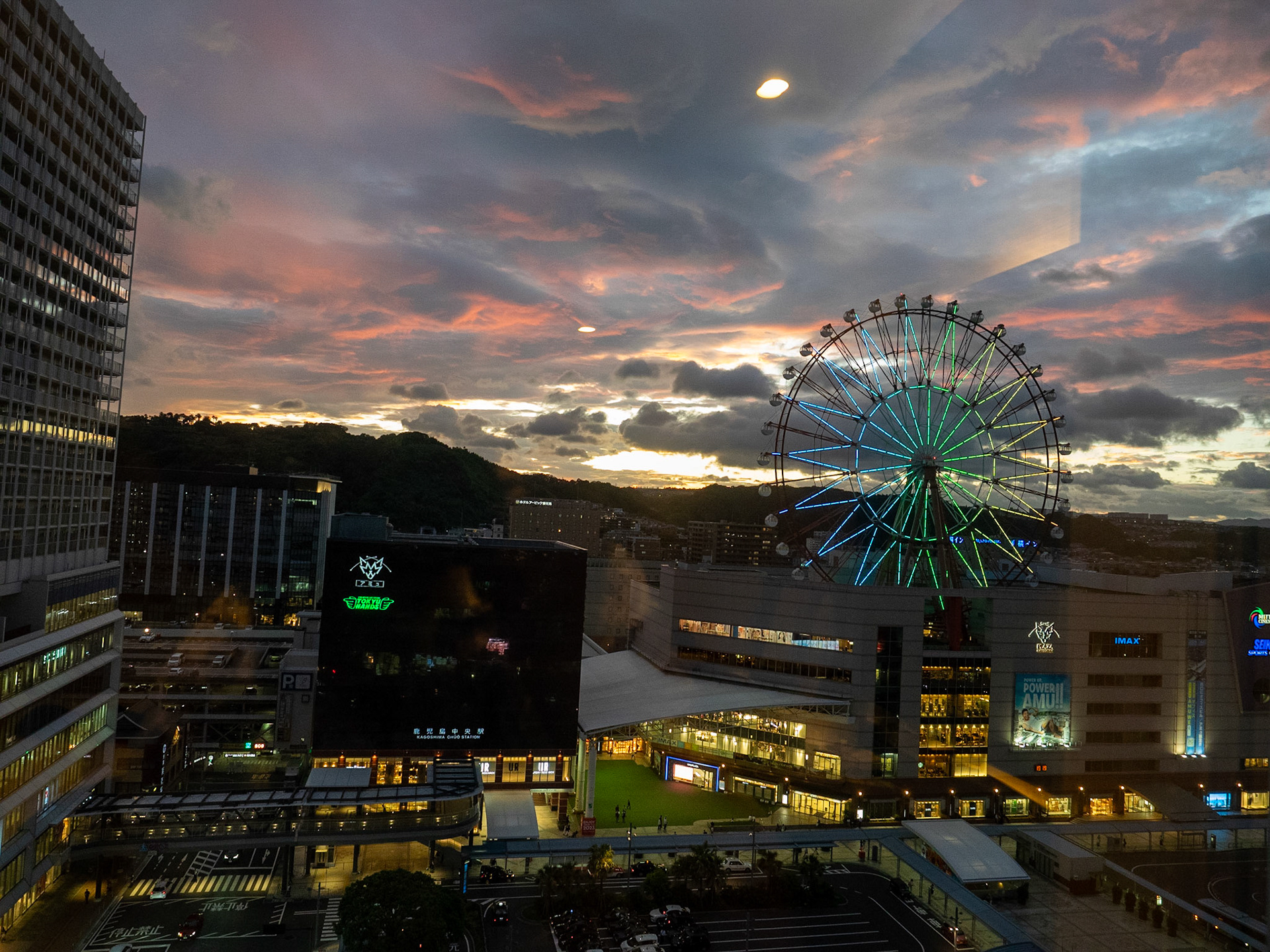
Kagoshima Station
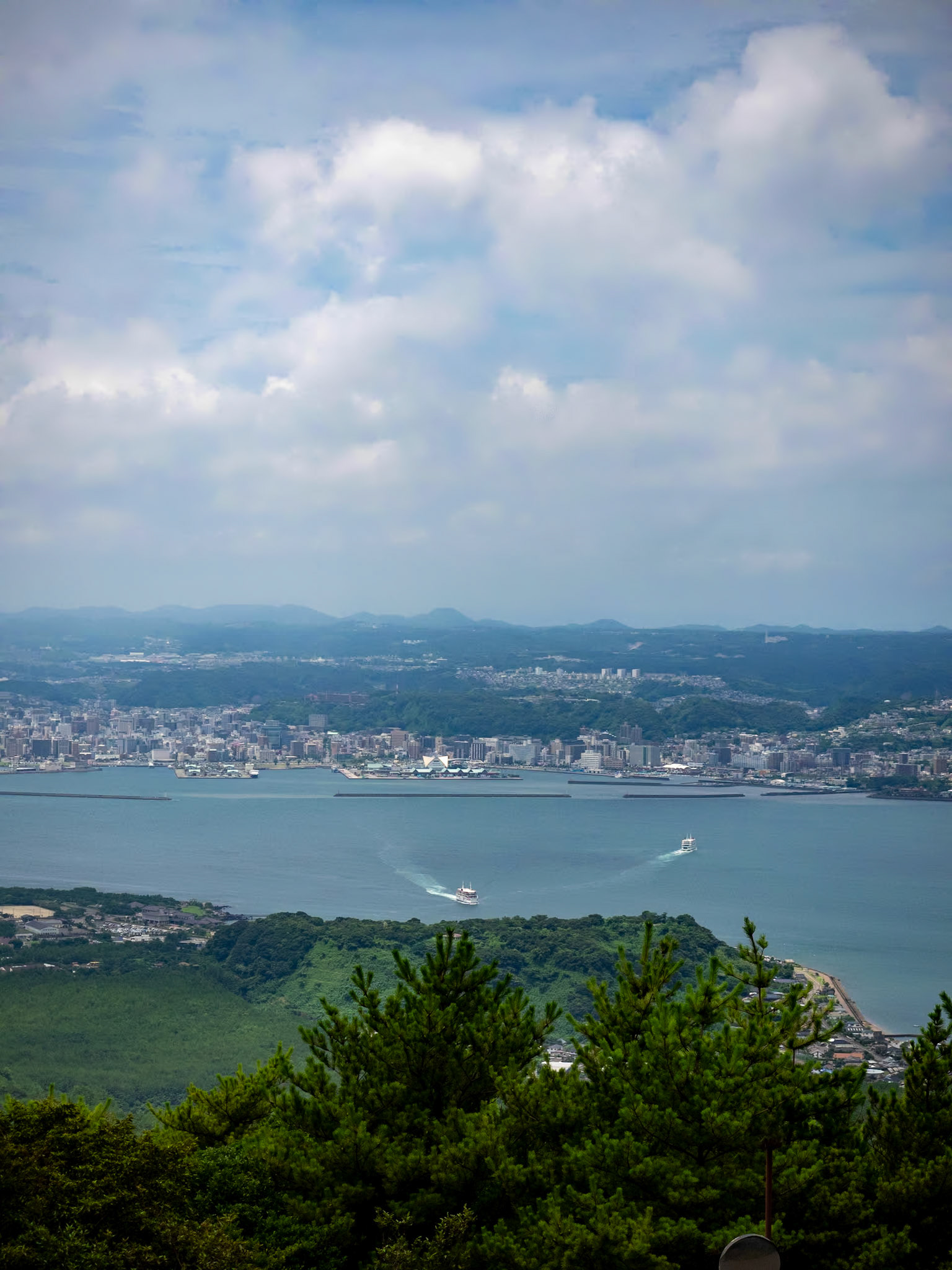
Kagoshima from Sakurajima
Kagoshima To Miyazaki
These next sections describe various sights along a possible driving route from Kagoshima north & across to Miyazaki on the east coast, then back to the centre of Kyushu & Mount Aso, then across to Kumamoto, Nagasaki, and on to Fukuoaka.
It's worth pointing out that at this stage, between Kagoshima and Kumamoto, we were driving just ahead of, and then during ,a fairly significant typhoon, with consequent gale force winds, and regular bursts of torrential rain. So I'm sure there are other places en route well worth exploring, which we skipped because of the weather conditions.
The first significant port of call north of Kagoshima is Kirishima Jinga. This renowned Shinto shrine is in the heavily forested mountains bordering Kirishima Kinkowan National Park. It's possible to take Express roads most of the way, but a more scenic option is to head north along the coast of the bay before turning inland. Note that at some point you will intersect the Kyushu Express road system however, and whoever coined the phrase "you can never go back" had obviously never encountered the spaghetti-like chaos of some Japanese interchanges, on roads, and off ramps in this part of Kyushu.
Anyway once you hit the mountains, the scenery is remarkable, passing through small, neat, onsen towns & resorts, past waterfalls, and over mountain streams.
From Kirishima Jinga head east towards the Nichinan Coast. Famous as a scenic coastal drive, the seaside shrine of Udo Jingu is well worth a stop. Before reaching the coast road the small historic town of Obi may be worth a stop. Towards Miyazaki there are some interesting geological formations known as the Devil's Washboard, along with a series of sandy bays and surf shops.
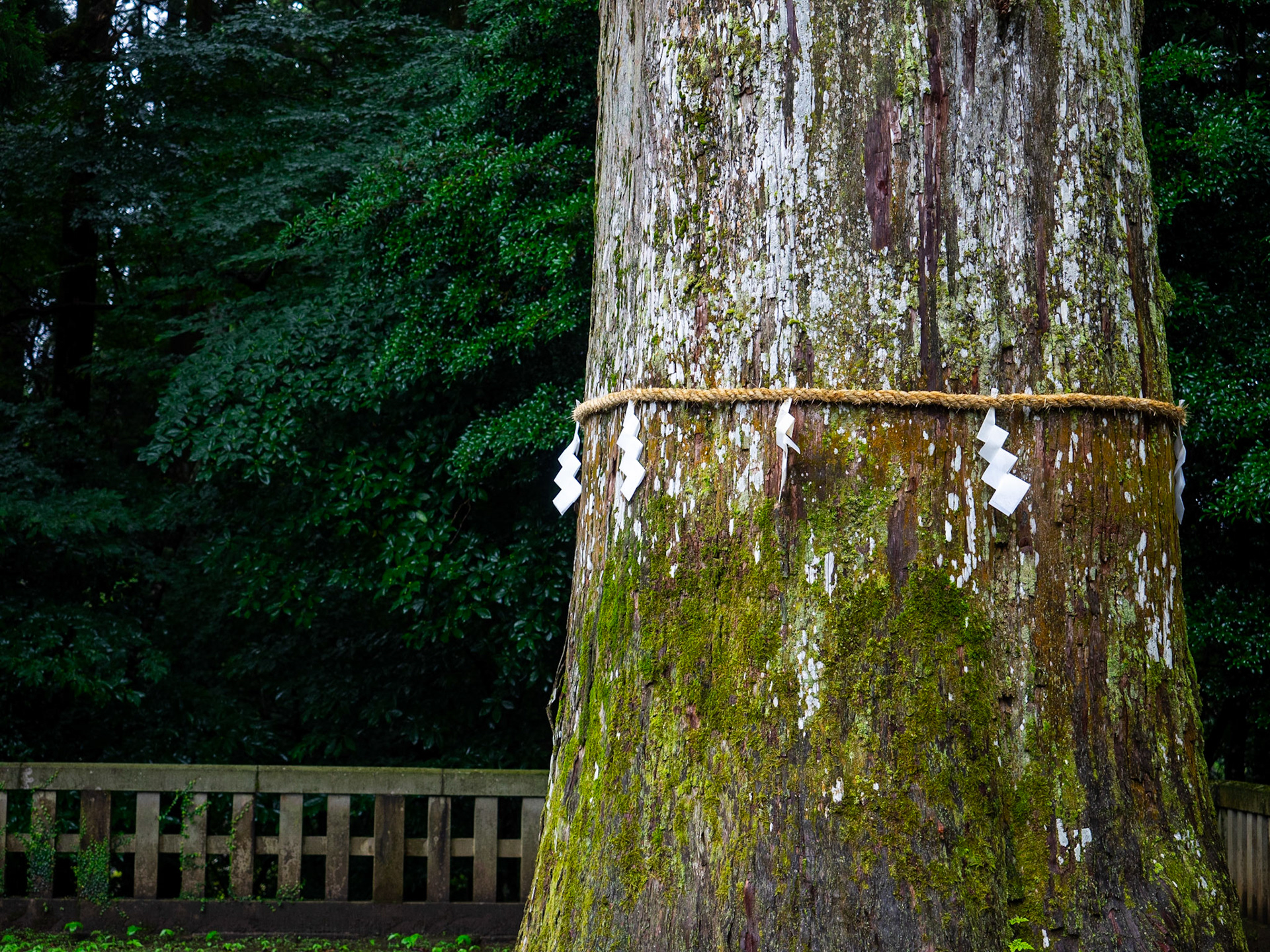
Kirishima Jinga
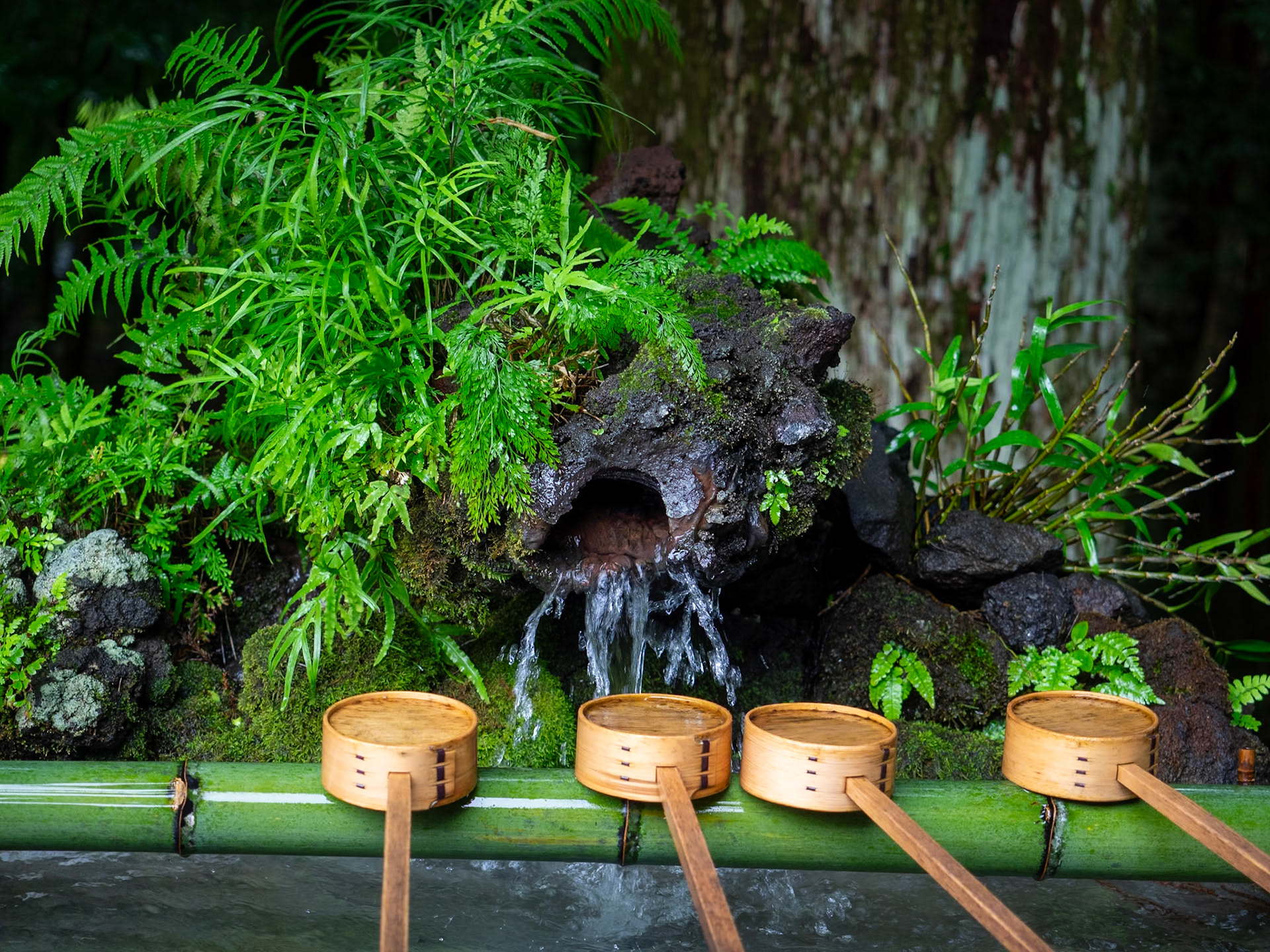
Kirishima Jinga
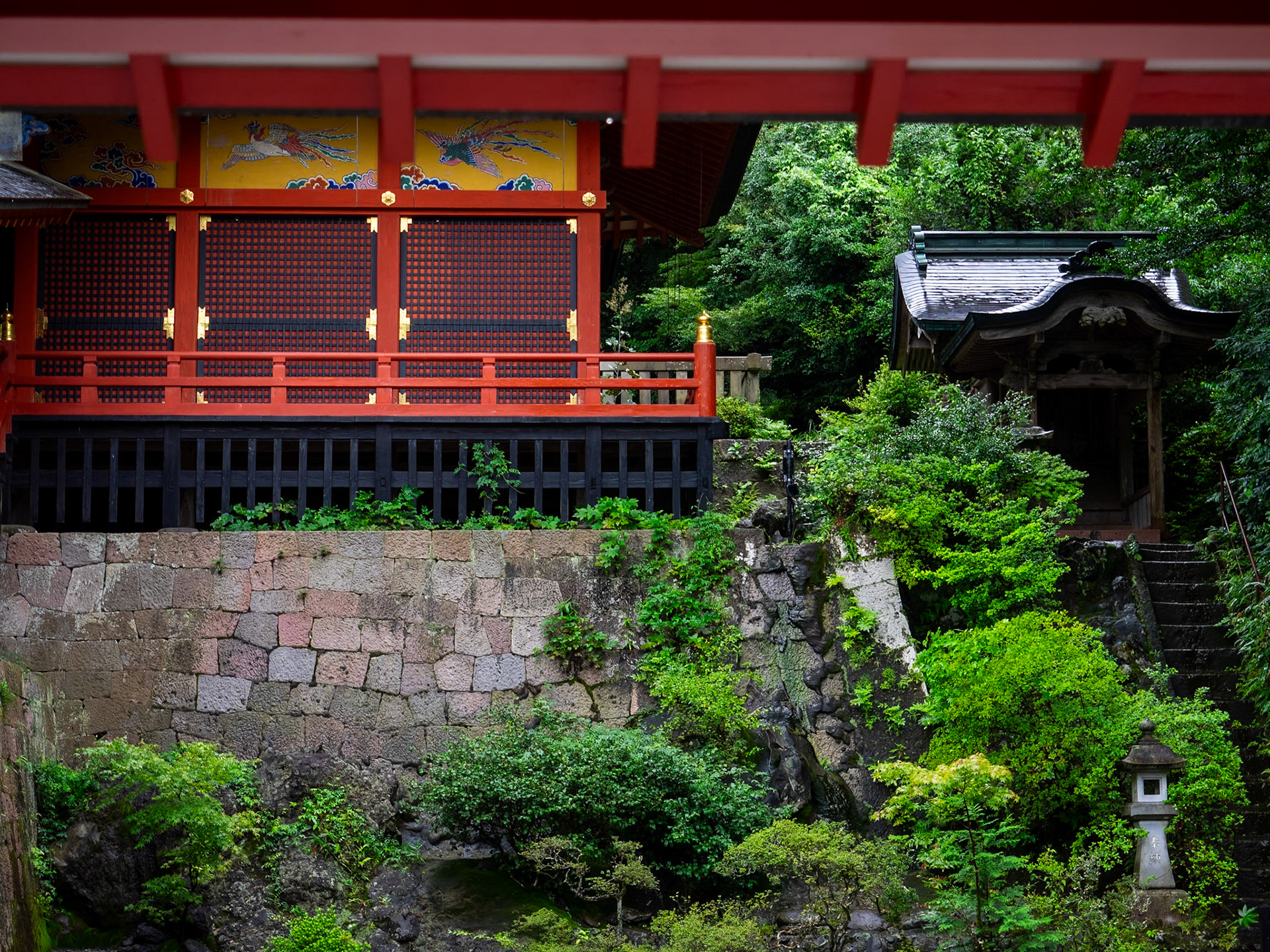
Kirishima Jinga
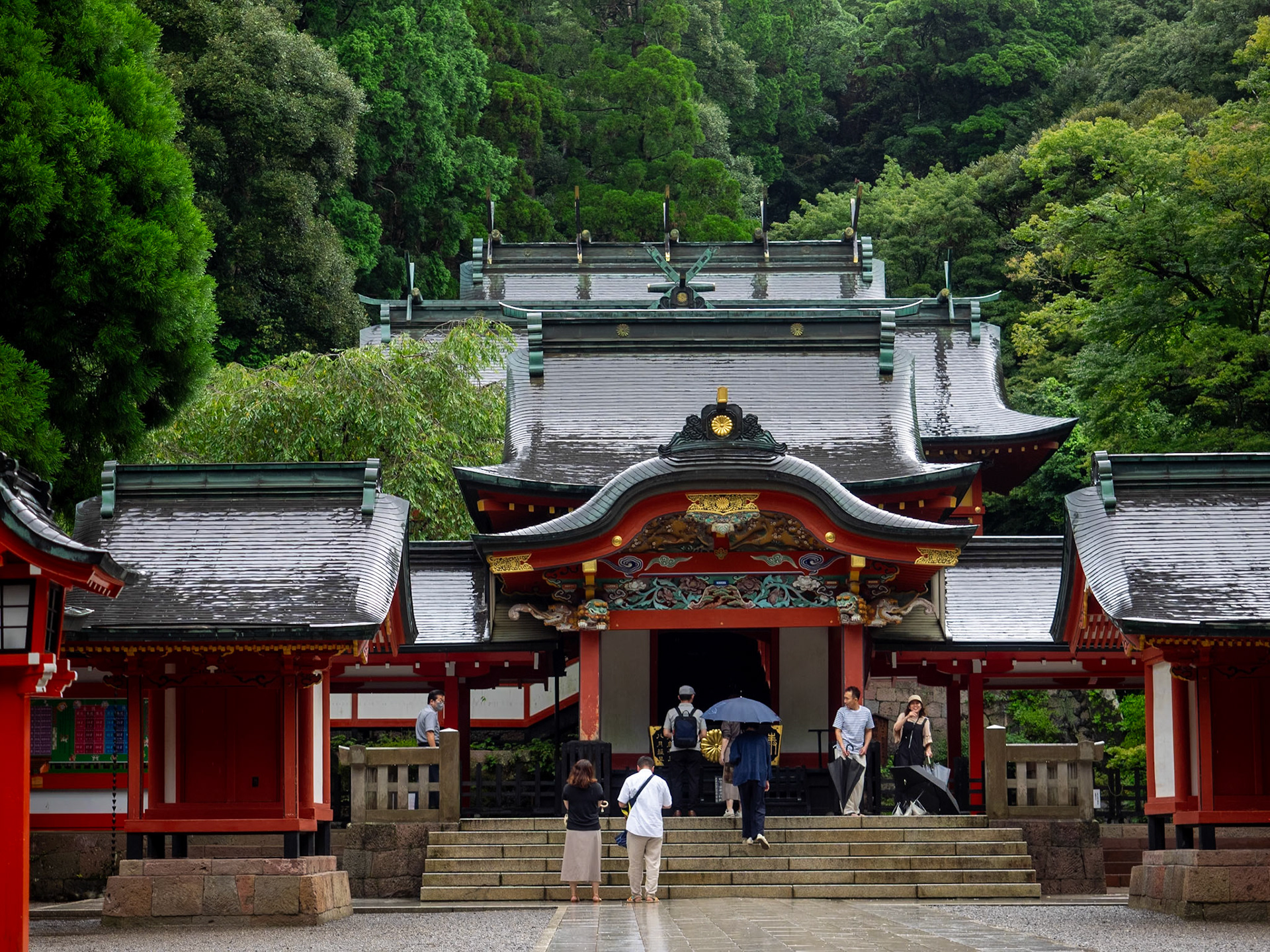
Kirishima Jinga
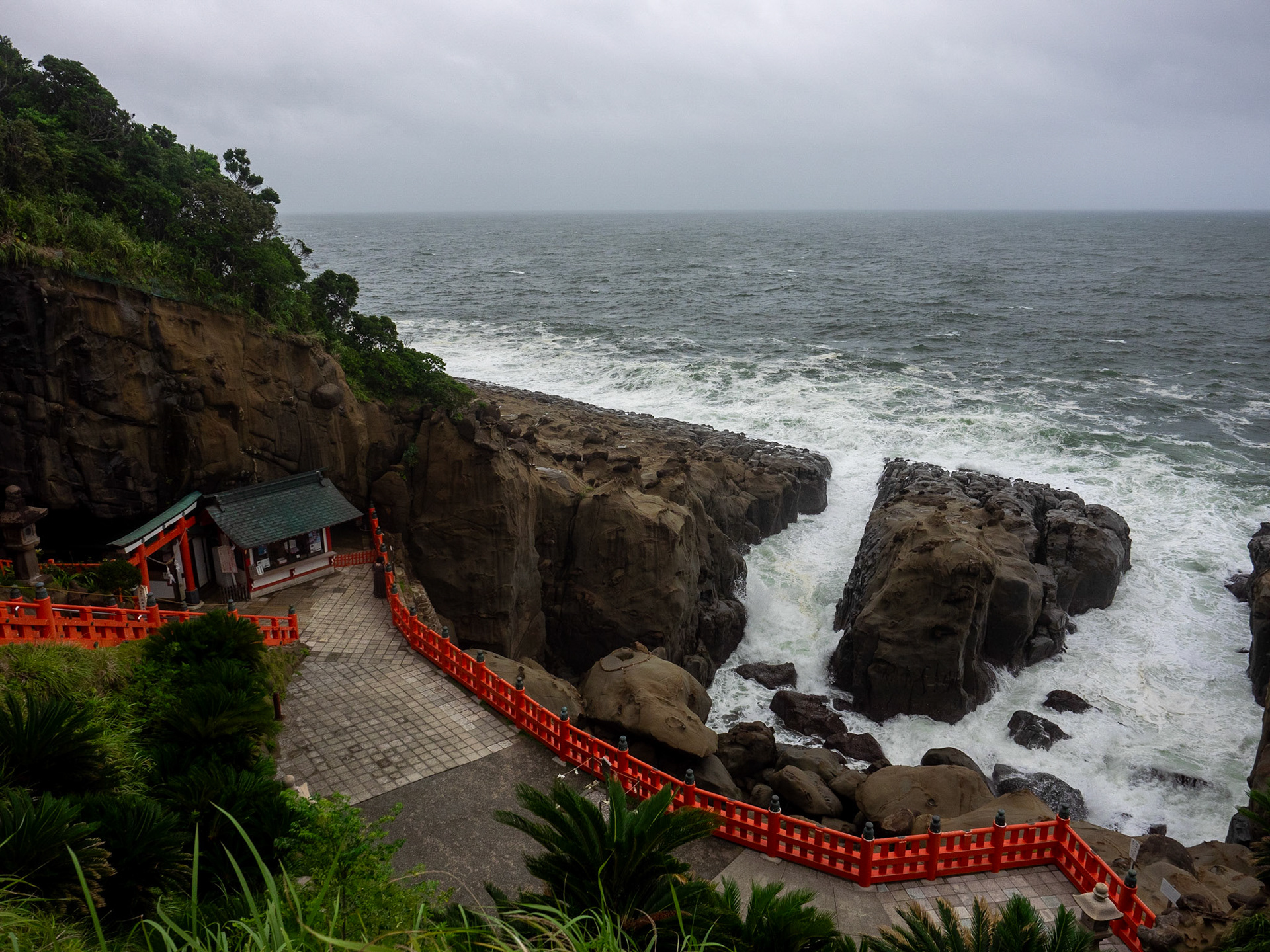
Udo Jingu
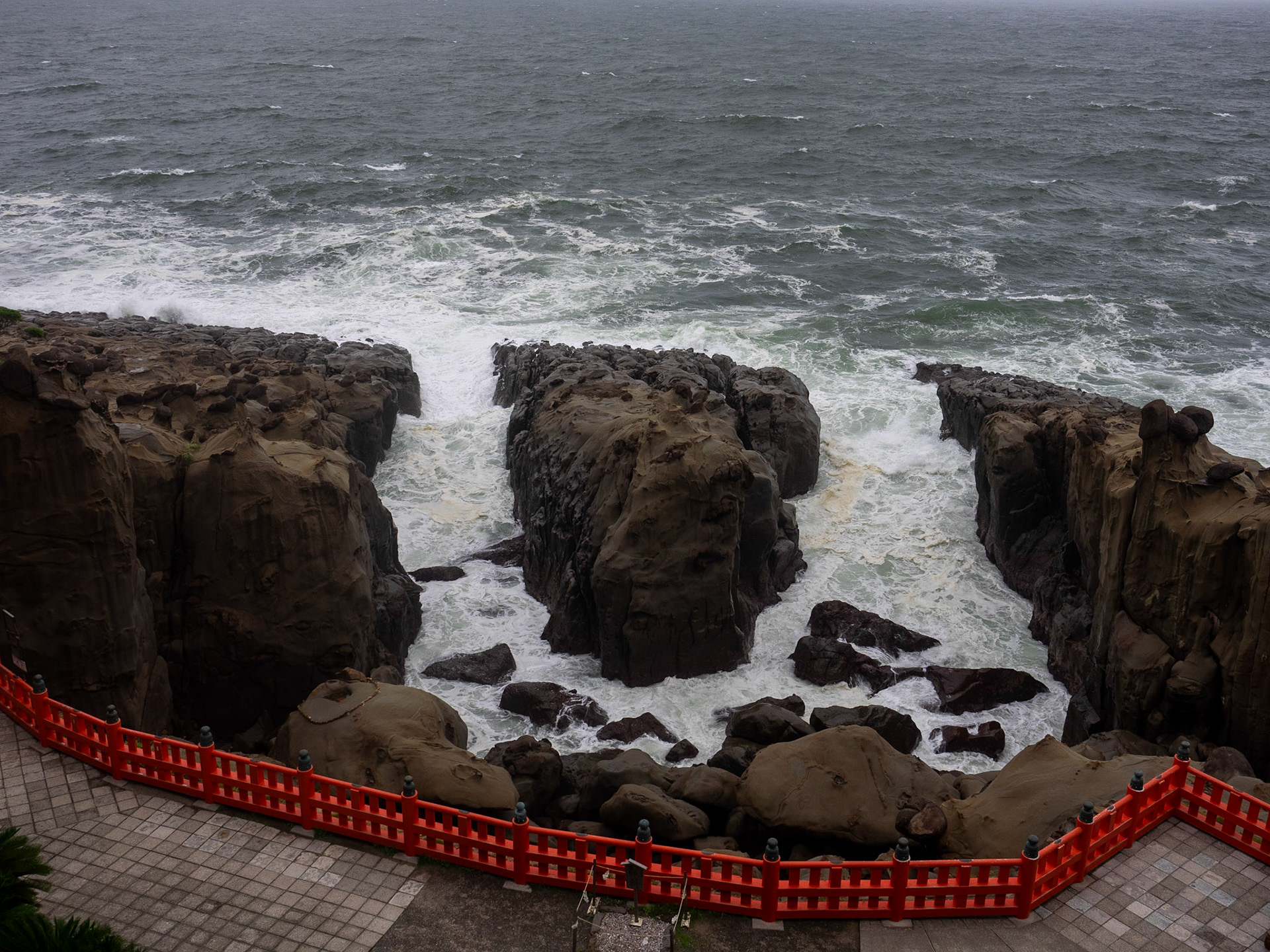
Udo Jingu
Miyazaki To Takachiho
The road to Takachiho, a pleasant little hilly resort town in the central mountains, becomes much more scenic once you turn off the coastal expressways from Miyazaki.
Takachiho itself makes a good overnight stop. Most well known for the Takachiho Gorge, with it's black granite cliffs, it's a very popular domestic tourist spot. Note that the scenic walking path along the Gorge is out of action for a couple of years due to ongoing landslide repairs. Takachiho Shrine is a particularly atmospheric small Shinto shrine in town, with a nice forested circuit walk if you need to stretch your legs.
Arriving into town from the east you also pass several stunning views of the Gokase River as it passes though even deeper gorges than that at Takachiho itself.
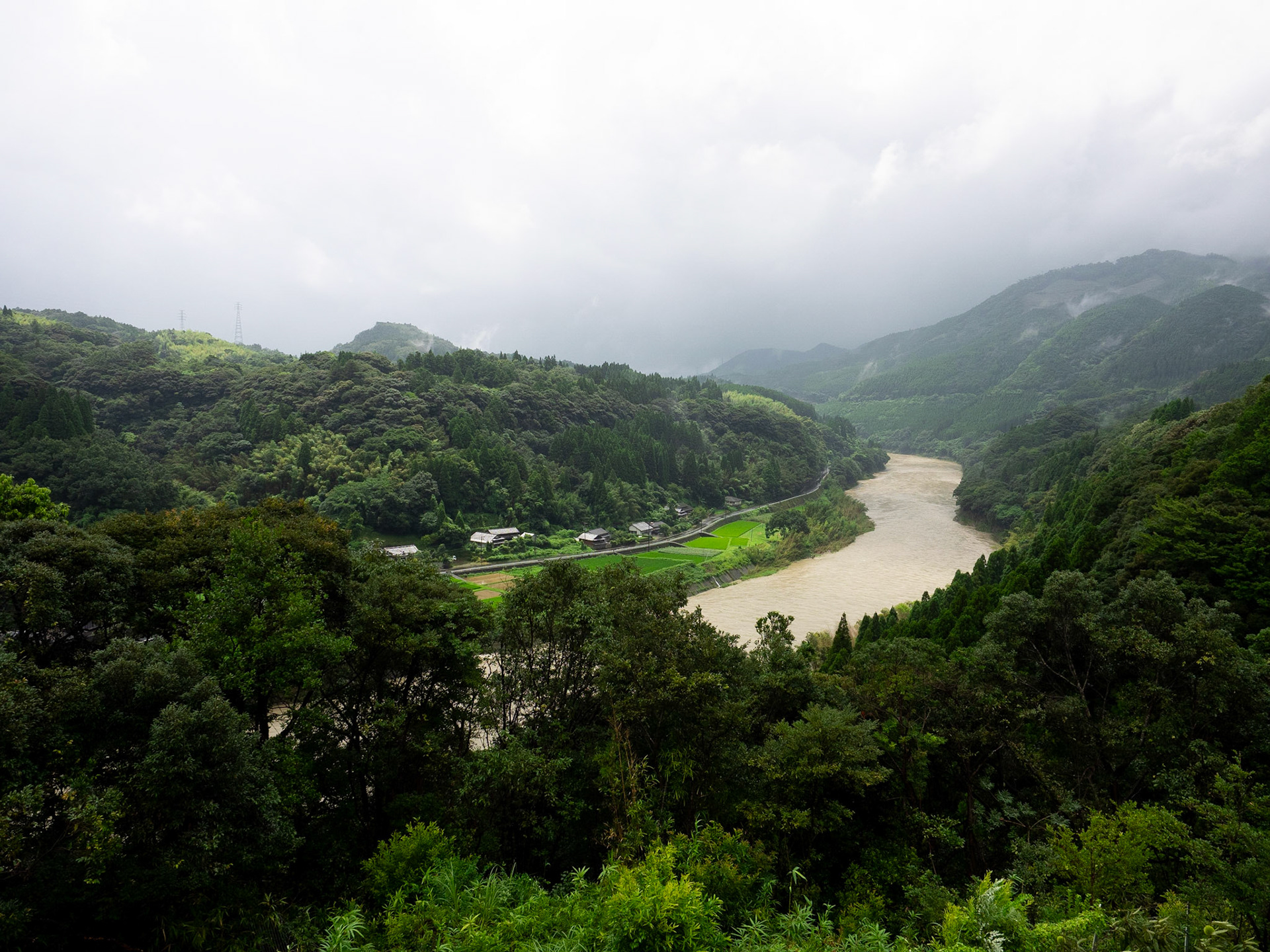
Roadside Stop, Miyazaki to Takachiho
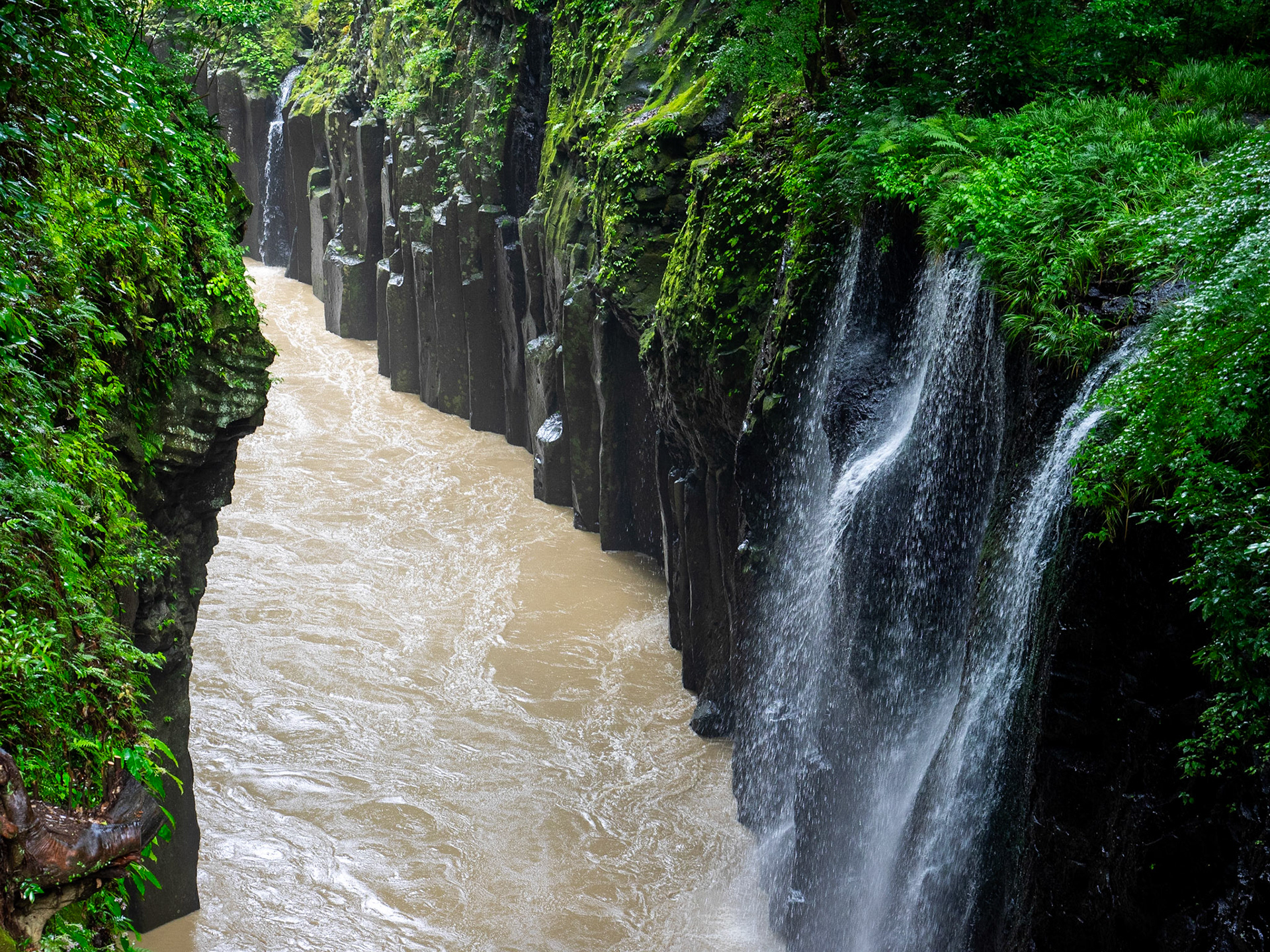
Takachiho Gorge
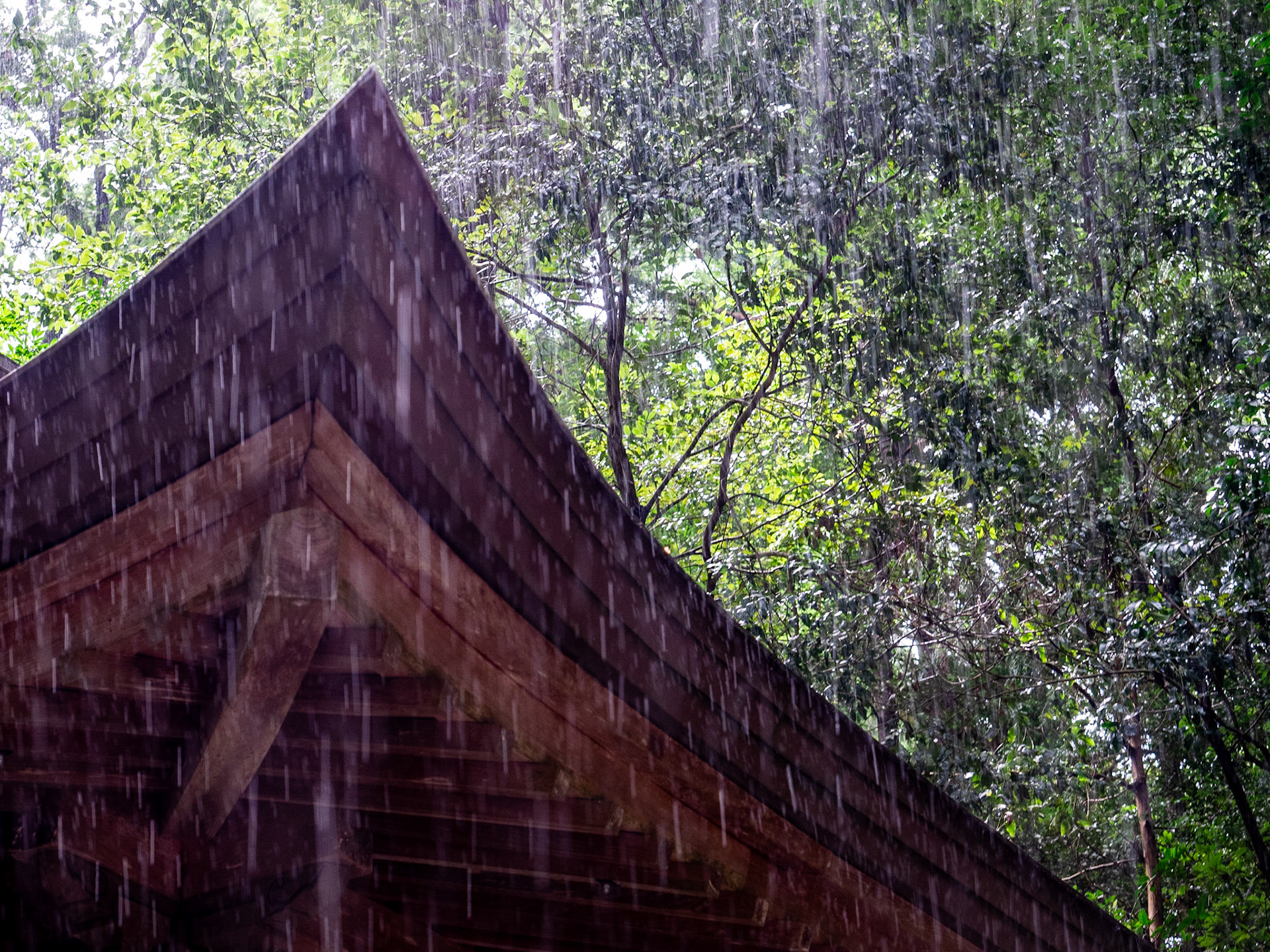
Takachiho Shrine
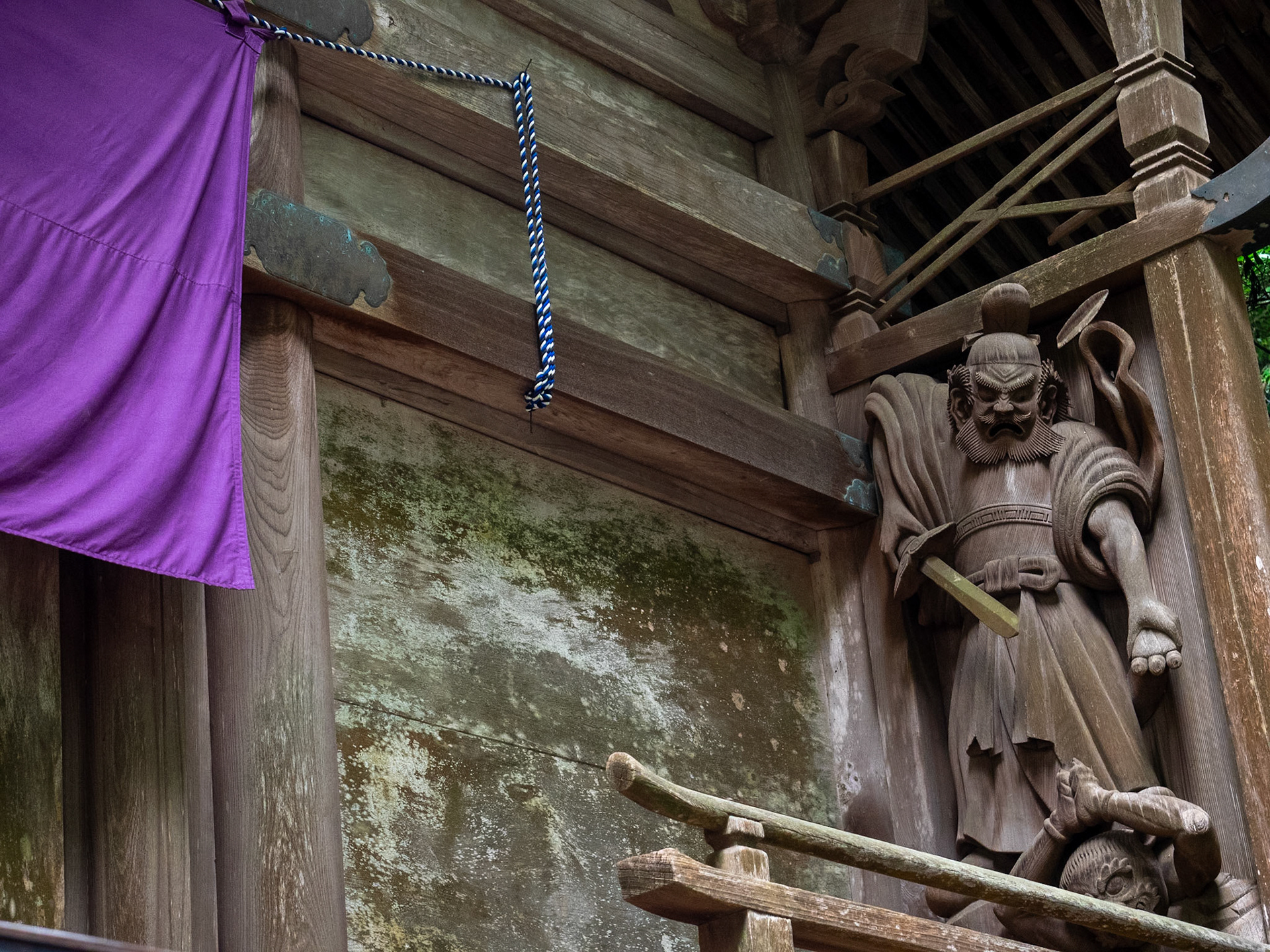
Takachiho Shrine
Mount Aso & Surrounds
Continuing north west from Takachiho, the road ascends the outer caldera wall of the Mount Aso region, then descends via hairpin bends to the caldera floor, and a variety of small towns dotted across it.
From this direction one of the first towns you come to is Takamori, home to the Takamori Yusui Tunnel Park, built inside an abandoned railway tunnel. This is a good opportunity for a quick dose of Japanese quirkiness, before dealing with the natural attractions beyond.
Mount Aso and it's surrounds are one of of the greatest natural sights in Japan.
Mount Aso itself is a particularly active volcano. Crater viewing is sometimes accessible, but also regularly restricted due to poisonous gases & fumes. Updates are available from https://www.aso-volcano.jp/eng/
Some people might hesitate about visiting here if the crater viewing is closed, or the weather doesn't promise a magnificent, clear, Aso sunrise or sunset.
Don't.
Such are the variety of landscapes, views, and experiences here that you won't be disappointed no matter what. For example, we visited during the onset of a typhoon, along with only a handful of similarly foolhardy, mainly Korean, tourists. The reward was watching the regions high altitude grasslands become a genuine green ocean - kilometres of grasses undulating in waves across the hills & landscape.
Each different approach to the caldera, and Mount Aso, also has it's own character. From Takachiho it's down wet forested walls; northward towards the onsen town of Kurokawa it's through undulating grasslands. (And a bizzare topiary display at Senbatsurushika Park.) From the Kurokawa direction you can continue west around the caldera rim on what's known as the Milk Road, with numerous observation points along it. Or descend again on the east side parallel to the ancient stone road in, the Aso Sankinkotai Road, with it's dark cultivated forests.
Kurokawa is probably the best place to overnight. Just beyond the caldera to the north this traditional onsen town has a range of ryokan accommodation, both in town, and spread out along the very pretty Tanoharu River.

View from Mount Aso
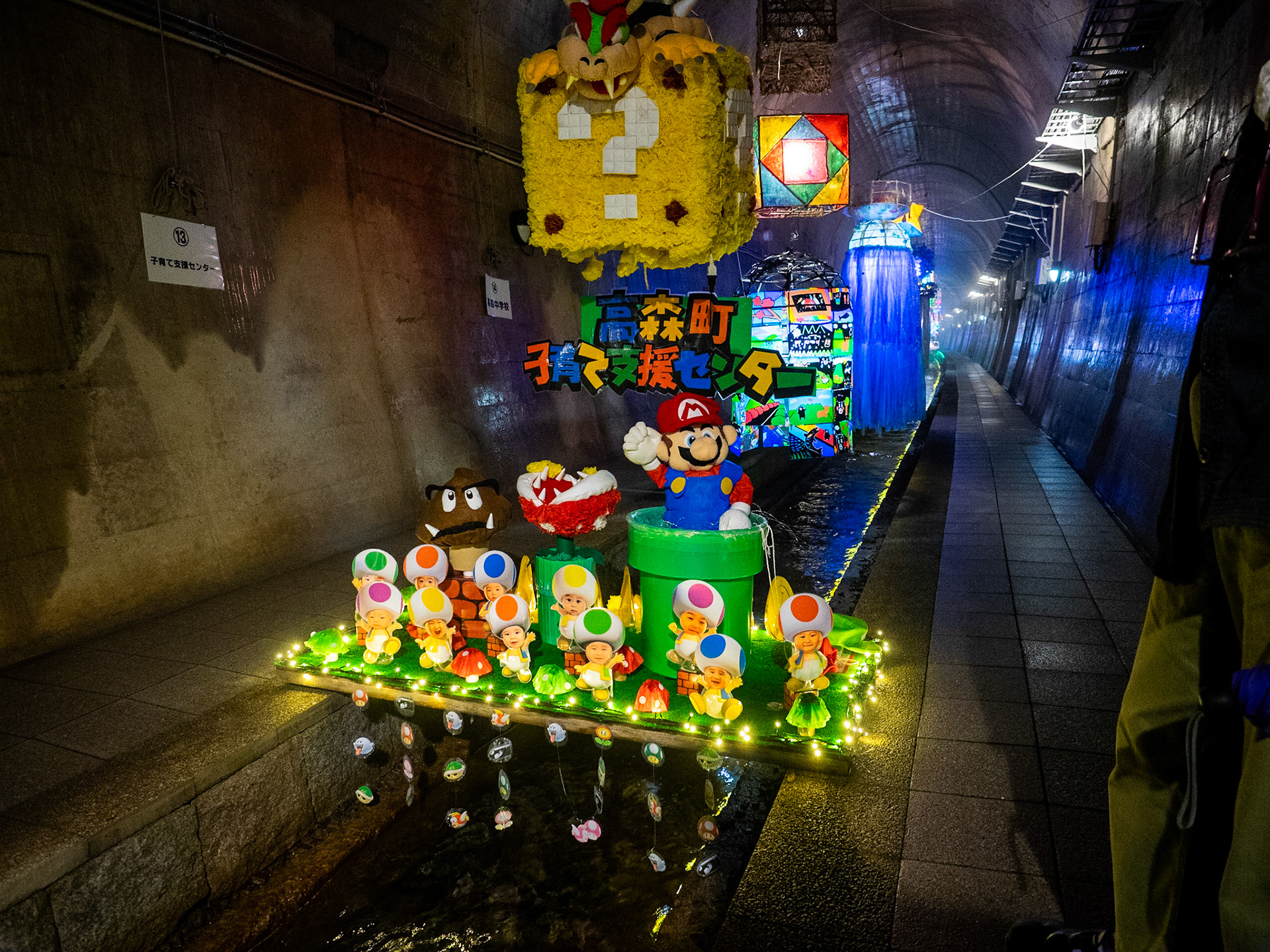
Takamori Yusui Tunnel Park
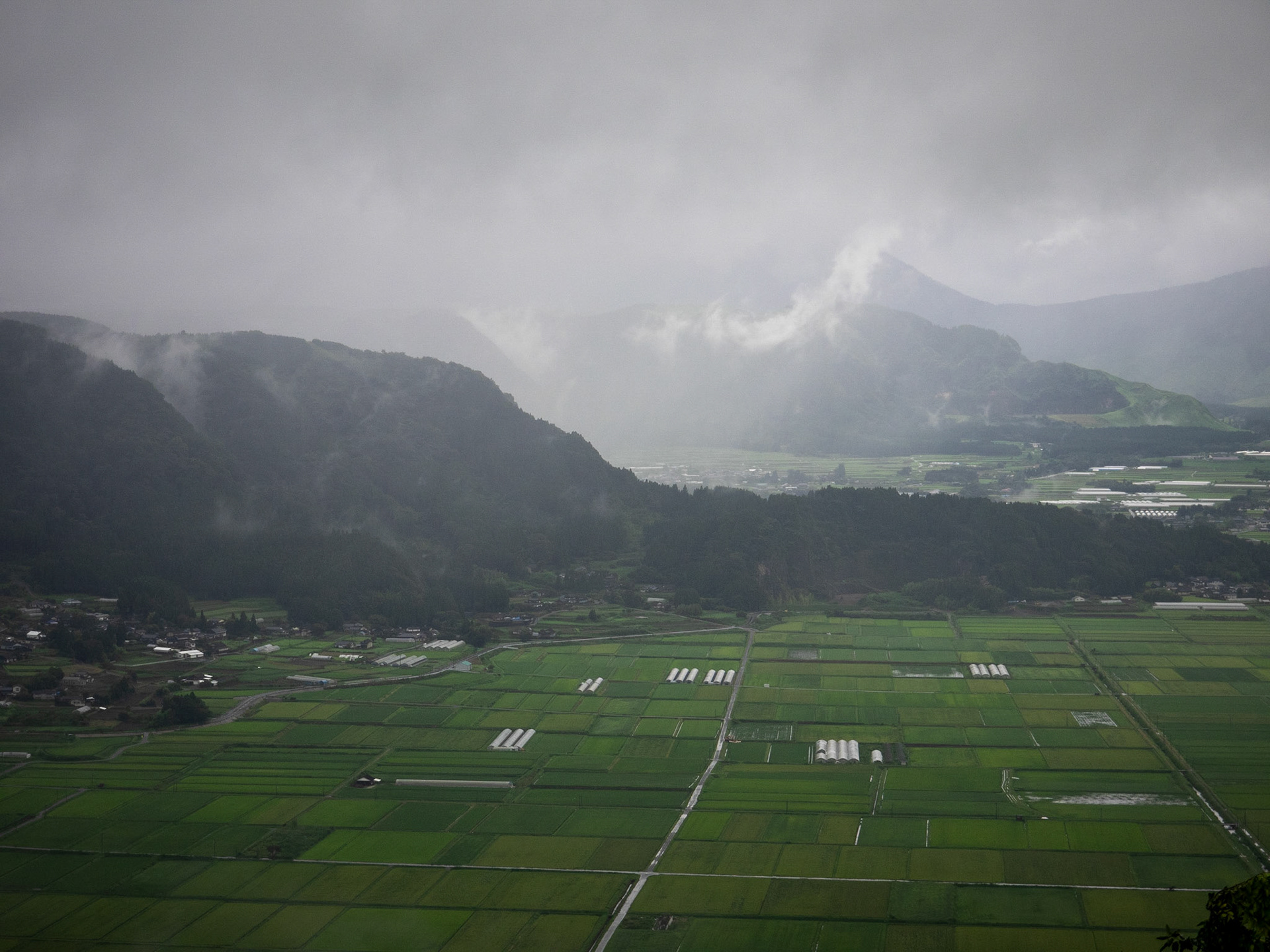
Caldera View, Mount Aso
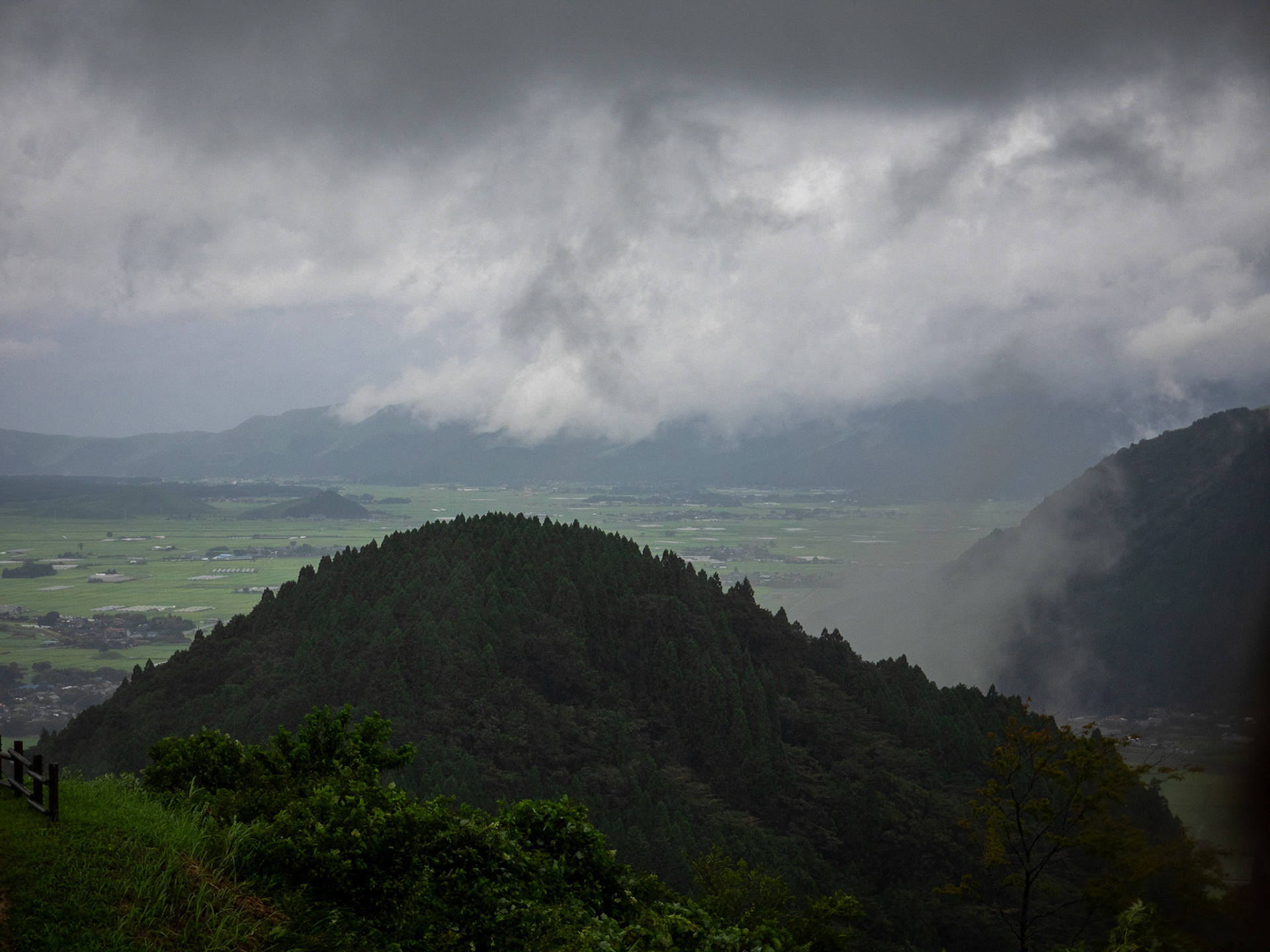
Caldera View, Mount Aso
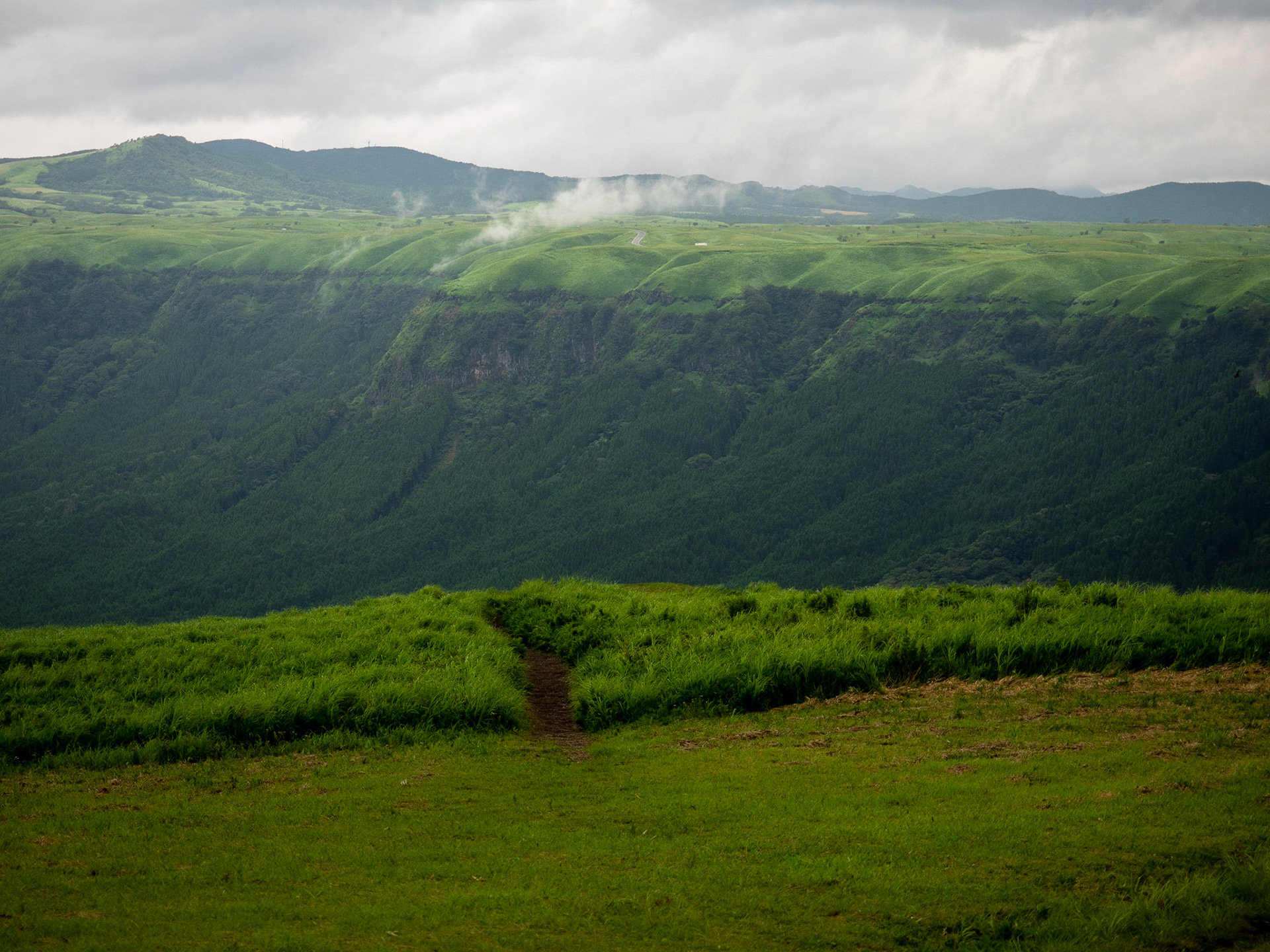
Caldera View, Mount Aso

Caldera View, Mount Aso
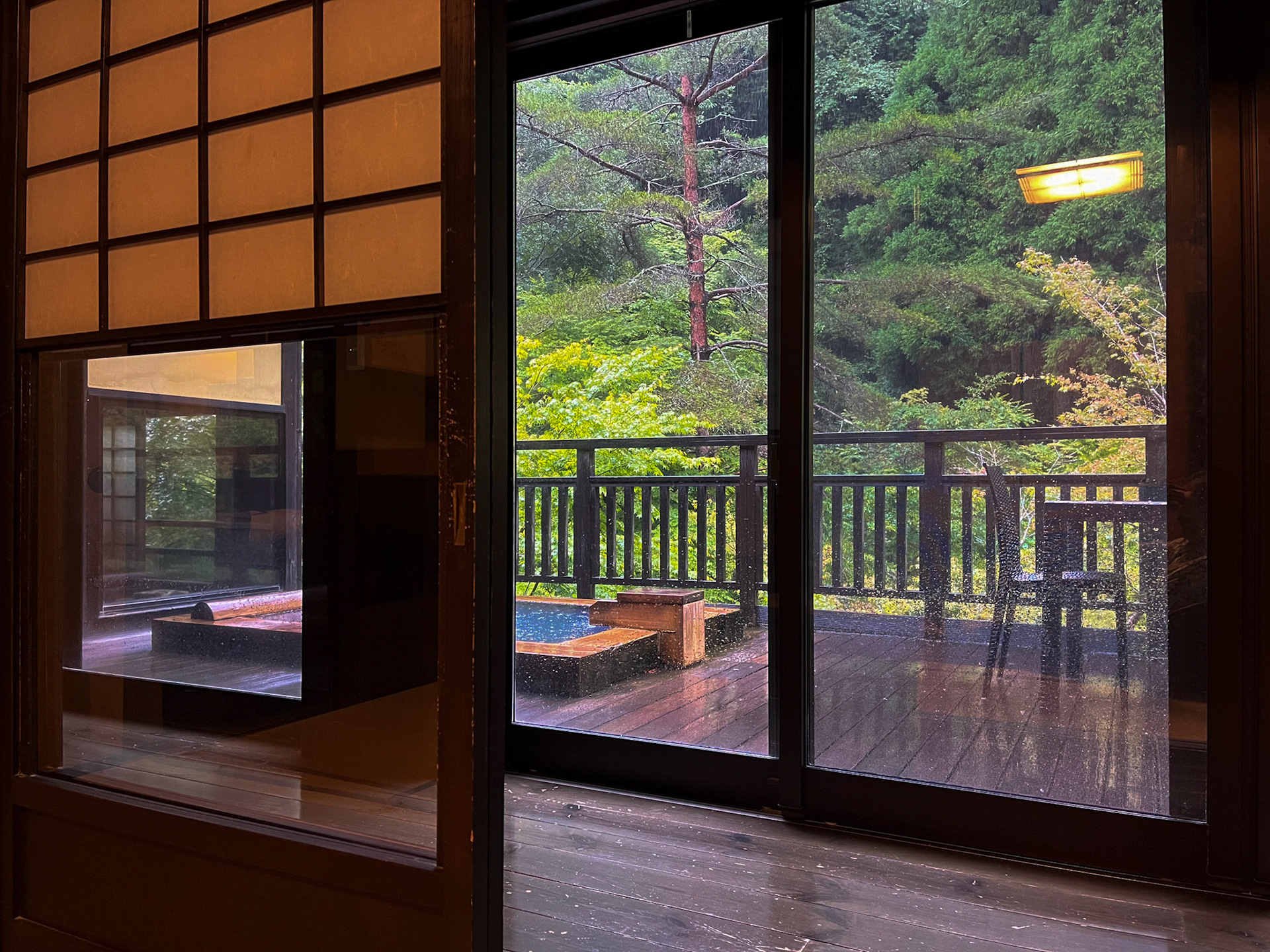
Ryokan, Kurokawa
Kumamoto to Nagasaki
From Mount Aso to Kumamoto it's a very straightforward 40 - 60 minute drive,
Kumamoto is a sprawling city, though the inner parts again have tram lines, which are very handy. One of Kumamoto's main attractions, apart from the castle which is undergoing major reconstructions after a massive earthquake, are the Suizenji Jojuen Gardens. Though I have to say I found these gardens a bit of a let down - design wise they mimic a strolling garden, but they're actually built around two main viewpoints only, with large mounds representing Mt Fuji, and other features supposedly representing the 53 stations of the Tokaido, between Tokyo & Kyoto.
Downtown is a lively eating precinct.
Normally, especially if you're driving it's recommended to take the ferry between Kumamoto & Nagasaki, via teh Shimbara Peninsula. Note that during Oban holidays the ferry doesn't take bookings, and the resultant queues can be enormous. So we took the long way round by road.
Nagasaki is indeed pretty, if exceptionally hilly. Again trams are your saviour here. The new shinkansen station, plus a renewed waterfront entertainment & cultural area a kilometre or so further along, look like becoming destinations in themselves. The food court at the station is bustling indeed, and several classic local restaurants have opened branches there.
Shimbara Peninsula
South & west of Nagasaki the Shimbara region has enough fascinating sights to easily fill a days travel.
Unzen Onsen is a thermally based resort town, which had an early heyday in the 1920's. Complete with it's own bubbling 'Hells', a pretty, expansive man made lake, and scenic back roads into town via the Chigootoshi Falls.
A few kilometres out of town takes you to a private toll road leading to the base station of the Unzen Ropeway. from the top there are fairly spectacular views of the Peninsula.
Note that Mt Unzen, which dominates the Shimbara Peninsula, has a recent history of quite violent & extensive eruptions, Check updates before you go. And for proof of this history, a final very interesting site in the vicinity is over on the east coast, at the 'Buried houses of Mt. Unzen eruption preservation park', which is exactly what it says on the box.
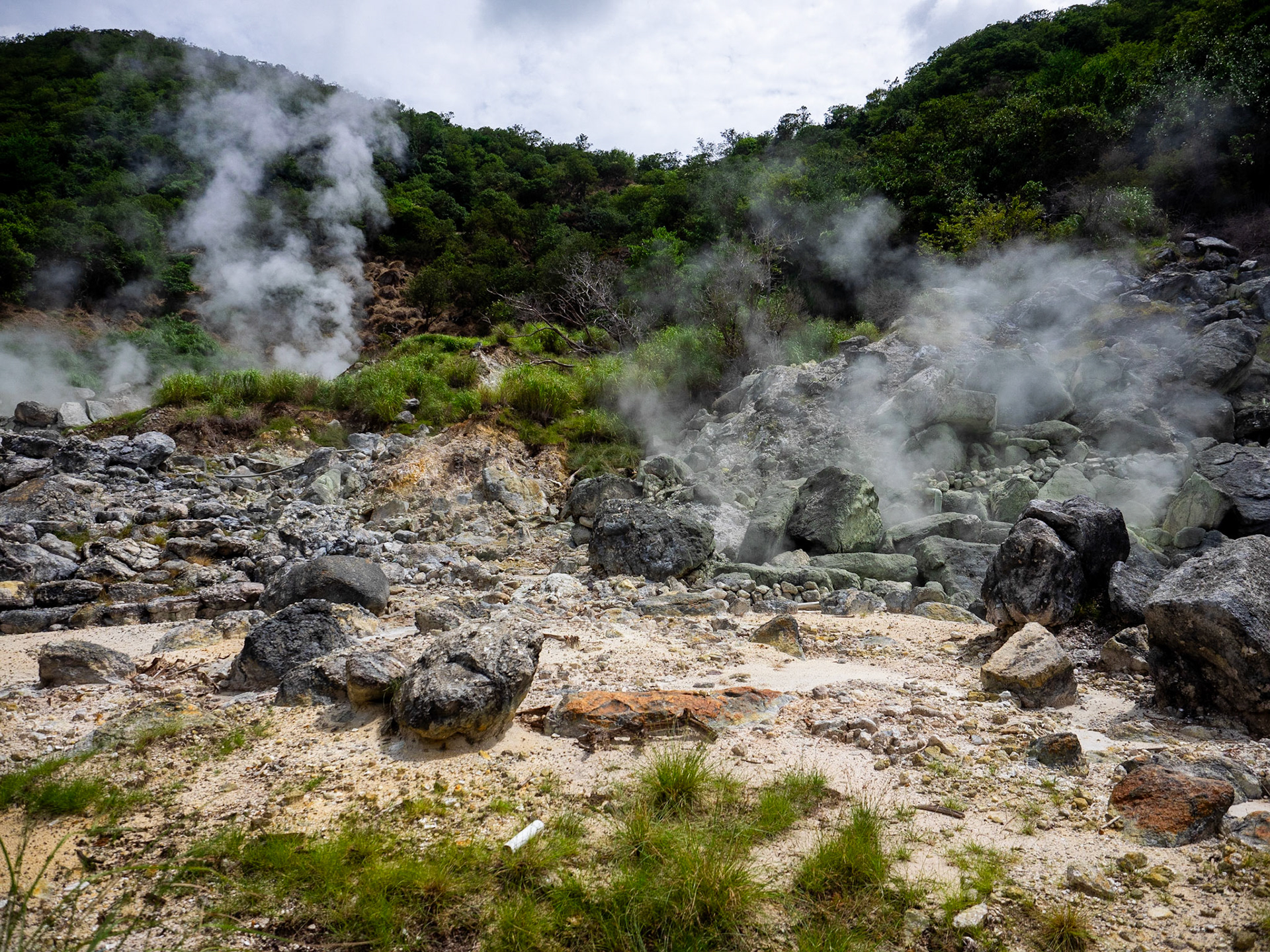
Hells, Unzen Onsen
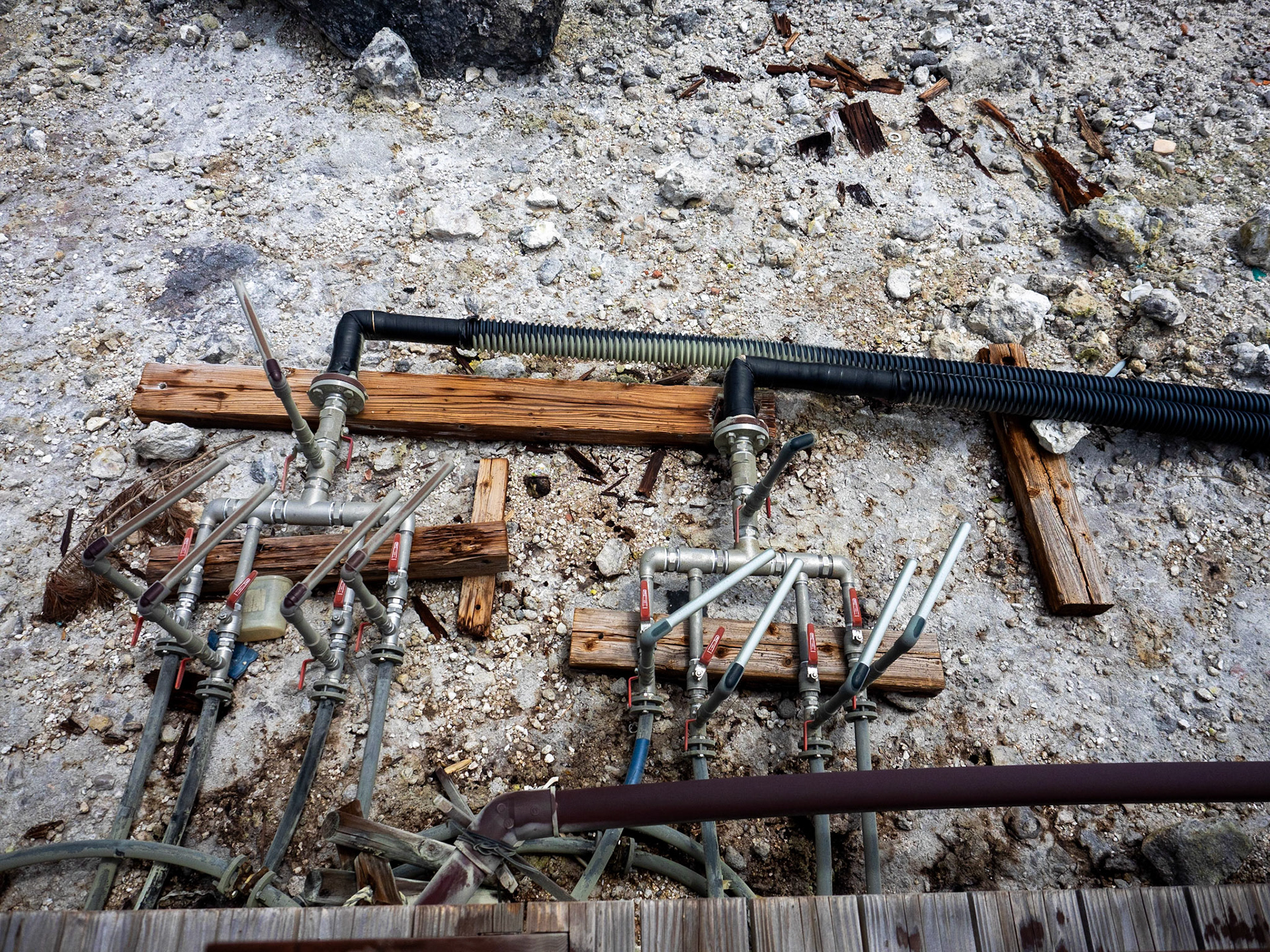
Onsen plumbing at the Hells, Unzen Onsen

Unzen Ropeway
Nagasaki To Fukuoka
Nagasaki to Fukuoka can be done via the shinkansen, or using expressways. However there are a couple of interesting spots easily accessible by taking more minor roads.
The first, closer to Nagasaki, is the Yutoku Inari Shrine, an imposing complex clinging to a hillside on the east side of the Nagasaki peninsula. One of Kyushu's major inari, or fox, shrines this is elaborately decorated, and overlooks the Hama River.
The second spot worth a stop are the Mifuneyamarakuen Gardens. A quite extensive garden, with dramatic use of borrowed scenery, these are good in summer, but would be spectacular in spring or autumn.
Closer to Fukuoka, you might be tempted to stop at the major shrine complex of Dazaifu Tenmangu. But if you're travelling by car, don't bother - traffic jams around here are a nightmare, especially during Oban, or weekends. You'd be far better catching a bus or train from Fukuoka.
Fukuoka itself is a quite pleasant very large city, with an efficient subway network, Though that comes with the usual caveat of getting lost trying to find the correct entrances & exits at the more crowded stations.
The Fukuoka Art Museum can have some striking contemporary exhibitions, well worth a look, and nearby, also on the shores of Ohori Lake are the Ohori Park Gardens, a small but very interesting modern take on Japanese garden design.
Also out of the centre of the city in that direction are the twin very modern attractions of Fukuoka for the locals - the Fukuoka Pay Pay Dome, home of the Seahaawks baseball team, and the adjacent Boss E-Zo Fukuoka, seven stories of homage to the Japanese love of amusements, from interactive baseball floors, giant electronic gaming rooms, a Teamlab Borderless exhibition (not one of their better ones - very child focused), and a mascot & souvenir driven Pooh Museum.
Historical Fukuoka get a nod with an interesting 2 or 3 hour walk through various temples shrines and museums in the Hakata area, between Kushida-jinja Shrine and the modern shopping mecca of Hakata station. None of these attractions are spectacular in themselves, but together they make a pleasant diversion.
Food wise, Fukuoka's yatai stalls get a lot of media. In consequence most were swamped by tourists before they even fully opened, so I'd suggest getting your Fukuoka food fix elsewhere. Which isn't difficult, but note that there is a huge rush for eating places at lunchtimes, with even more queuing than we noticed in Tokyo.
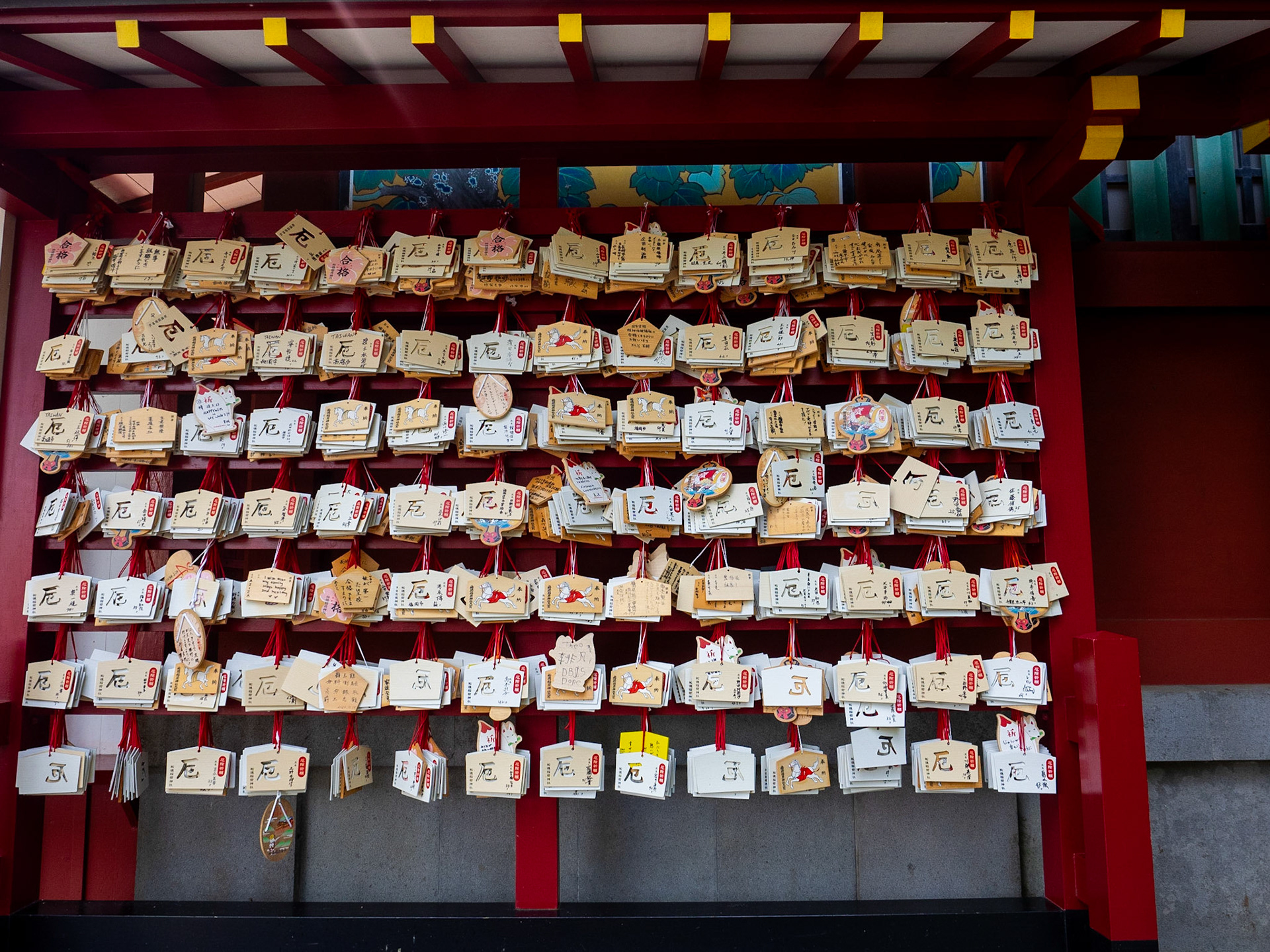
Yutoku Inari Shrine
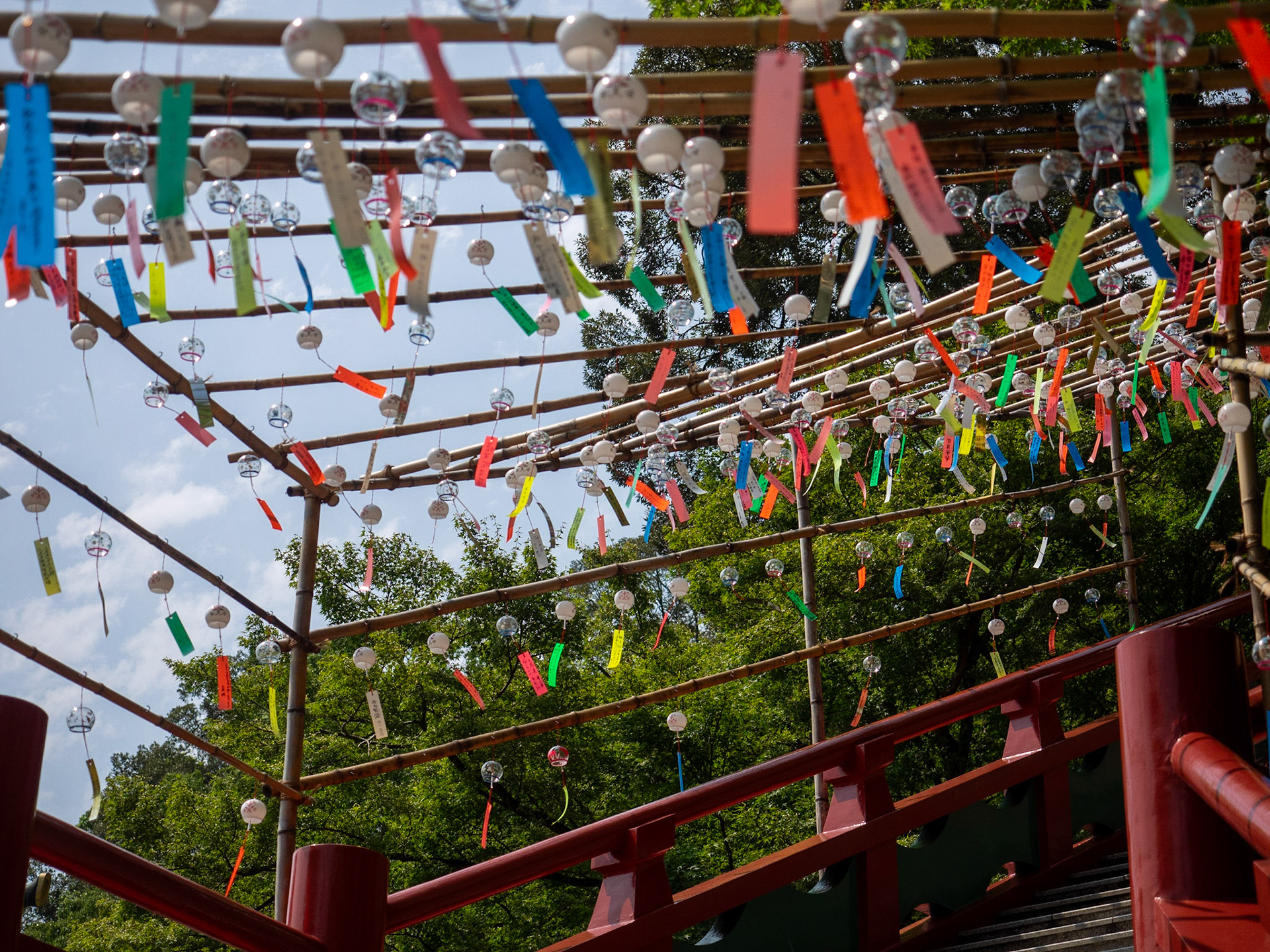
Yutoku Inari Shrine
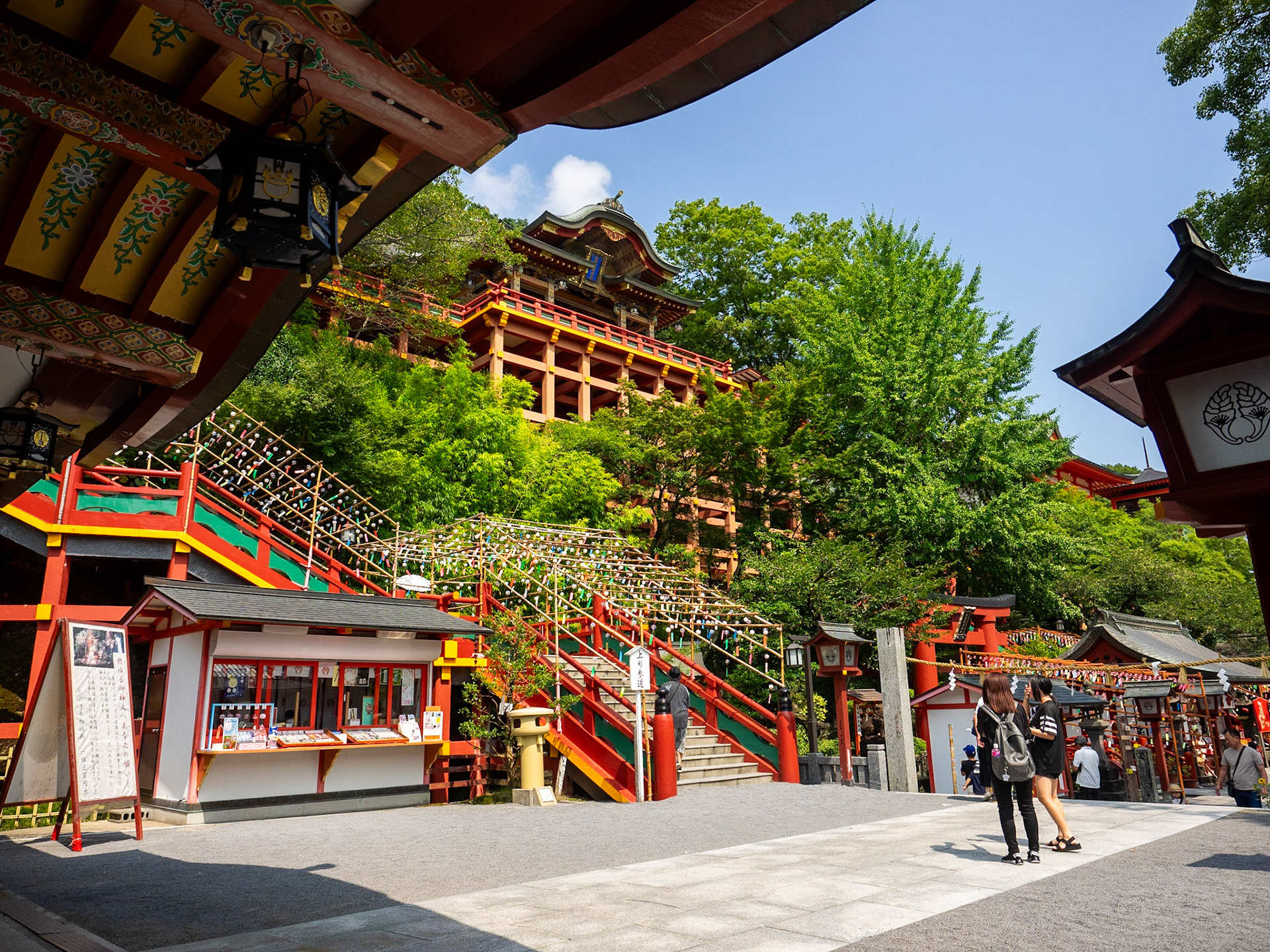
Yutoku Inari Shrine
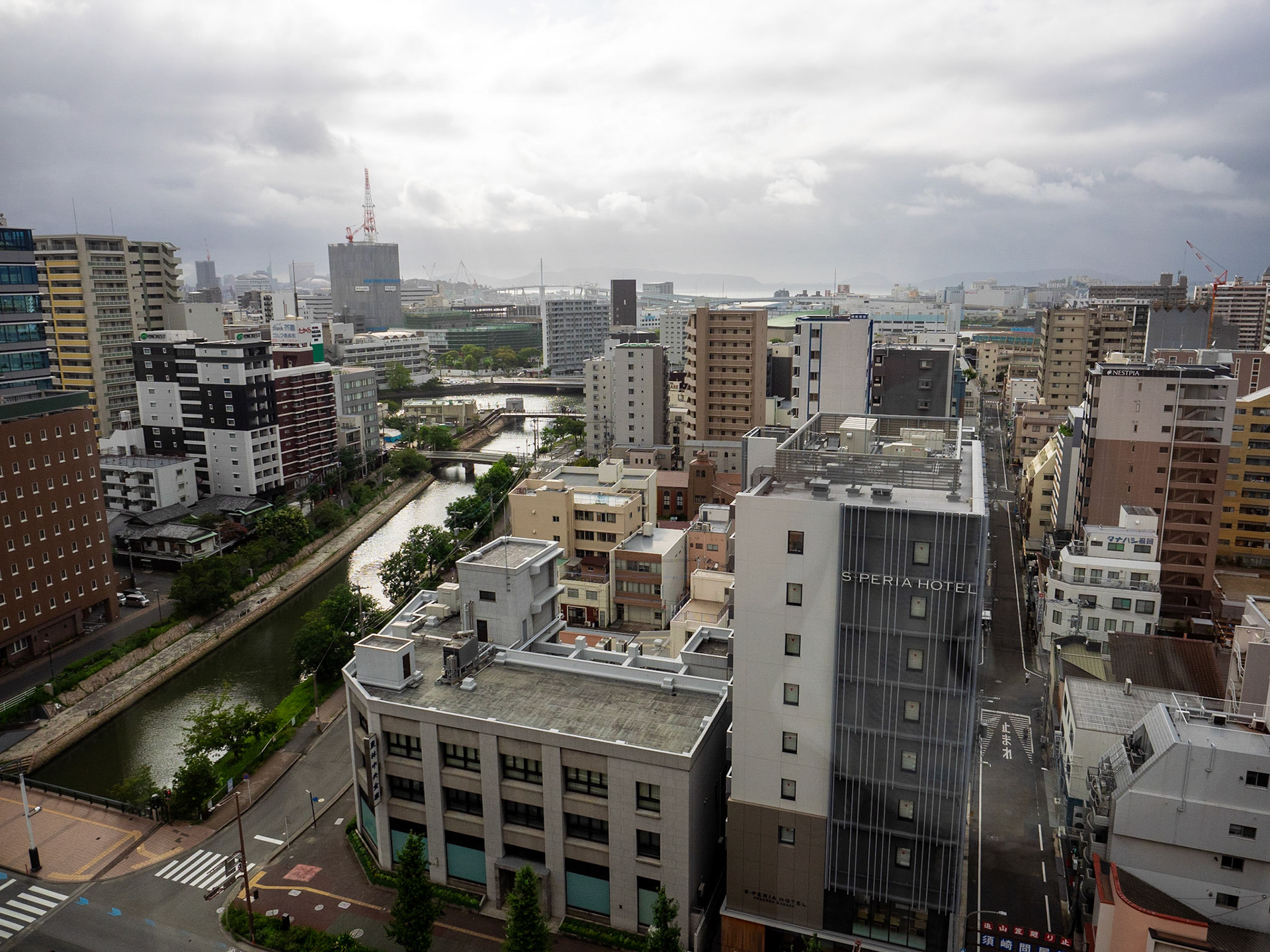
Fukuoka
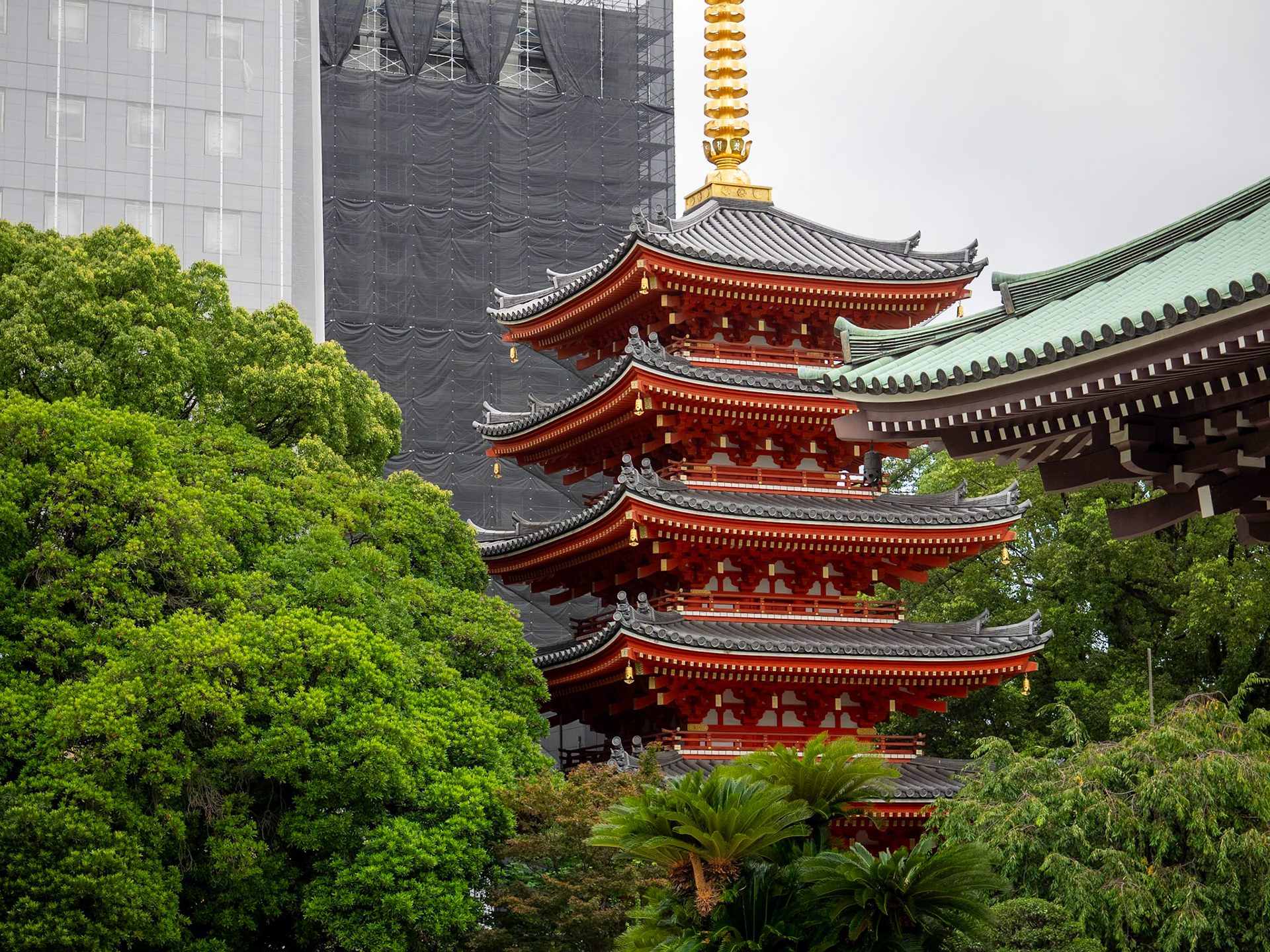
Fukuoka
